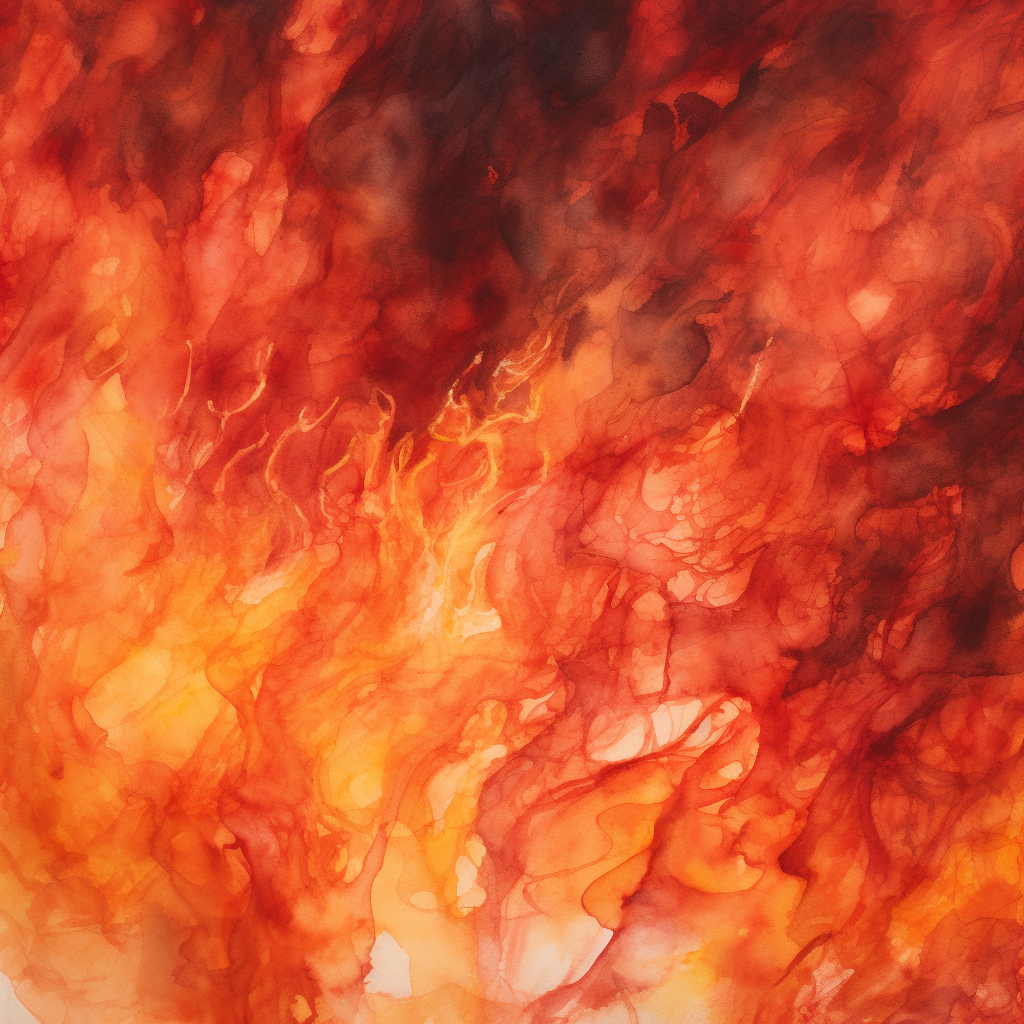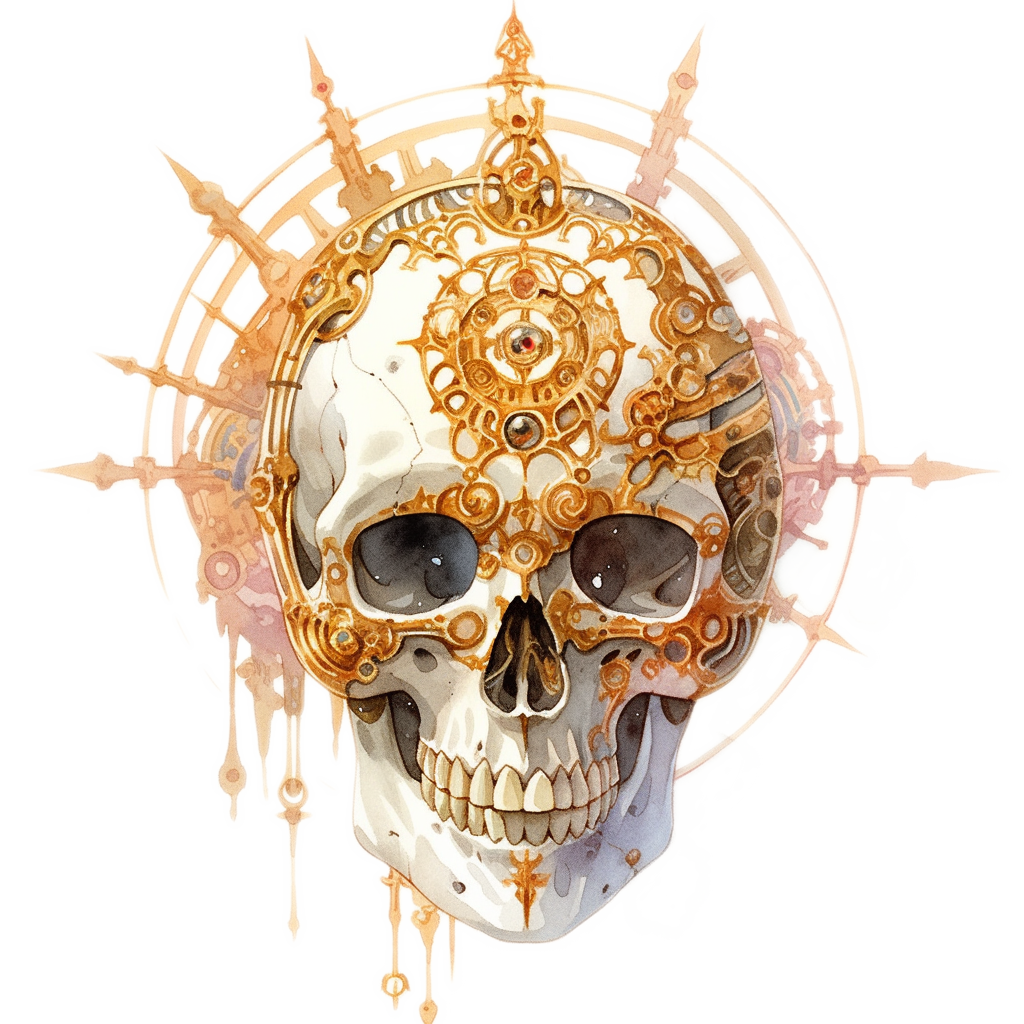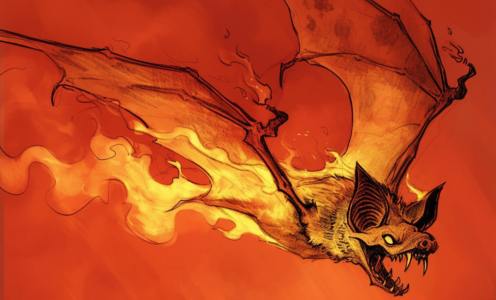[ Fire ] [ Mapping Infinity | Pockets | Locations | Powers | Clans | Bestiary | Flora ]
A Bestiary of Fire
No mundane creatures live in the Crematorium—the heat is just too much. Yet if you think that the Plane of Fire is some kind of desert, where only mindless elementals live, you’d be wrong. And if you think you can easily hunt and forage for food in this plane, you’re also gravely mistaken. See, most creatures throughout the planes are water-based on some level at least, but liquid water just can’t exist in the Plane of Fire. So, biological inhabitants of the Crematorium have other substances flowing through their veins. They can be liquid fire, acid, molten metal or something else, but best be sure it’s usually something very poisonous. This also means that water and cold are often dangerous to them—though on the Plane of Fire this knowledge is less useful. Most elementaloid creatures maintain spiritual contact with their element. In case of fire elemental creatures, it’s their innate heat or at least warmth, that persists in their flesh even when their surroundings are much colder. This innate heat is what animates fire elementaloids—some of them draw almost all their sustenance from the fire of their home, only having to eat to get some special nutrients.

Flaming Flora and Fiery Fauna
“Ah, the flora and fauna of the Plane of Fire—an infernal menagerie of wonders and horrors, each more blisteringly bizarre than the last. Let’s start with the locals, shall we? The fire elementals are the true children of this plane, so much more than living flames that flicker and dance across the lands. Some are grand infernos, towering over the dunes of ash, while others take on smaller, animal-like forms—a pack of ember foxes prowling for prey, or a flock of phoenix-like fundamentals trailing molten sparks through the haze. Then there are the salamanders, those molten serpents who slither between servitude and rebellion with sinuous grace. Their young, the fire snakes, are wild and untamed, writhing through rivers of magma like living currents of fire. And let’s not forget the mephits—those cackling little pests flitting about in small groups. Fire mephits are most common of course, but you’ll also find their smoky, ashen, and even radiant cousins stirring up trouble wherever they go.
“And what of the plants? Oh yes, even here in this blazing inferno, life finds a way—though it’s a way that would likely set your delicate Prime Material sensibilities ablaze. The ash willow sways its blackened branches in the hot winds, while serpent trees twist like frozen flames with bark that glows faintly from within. The rare salamander orchid blooms with molten gold petals that shimmer like liquid fire—a treasure worth more than your weight in rubies (and far harder to steal). In the Obsidian Fields near my glorious City of Brass, you’ll find crops like crimson rye, flame cloves and habbat grain cultivated by those clever enough to harness heat as sustenance. But beware the tergamit fruit—it may be a fiery delight for an efreet palate like mine, but for your kind? It’ll burn you from the inside out faster than you can say “bad idea.”
“Even the simple beasts here defy reason: lava worms burrow through solid fire; fire bats hunt glowing hornets; and animentals—living constructs of pure flame—glide through seas of liquid fire or dart through the smoke-choked skies. Every flicker of life here celebrates survival in a place that hungers to consume all.
“Here then is a list of some of the wonders you might encounter in the most glorious of planes…”
— Tadj-al-Saltaneh Tiznaa bint-Saatadeh al-Mamaalek

A Bestiary of Fire
Aasimon, Monadic Deva
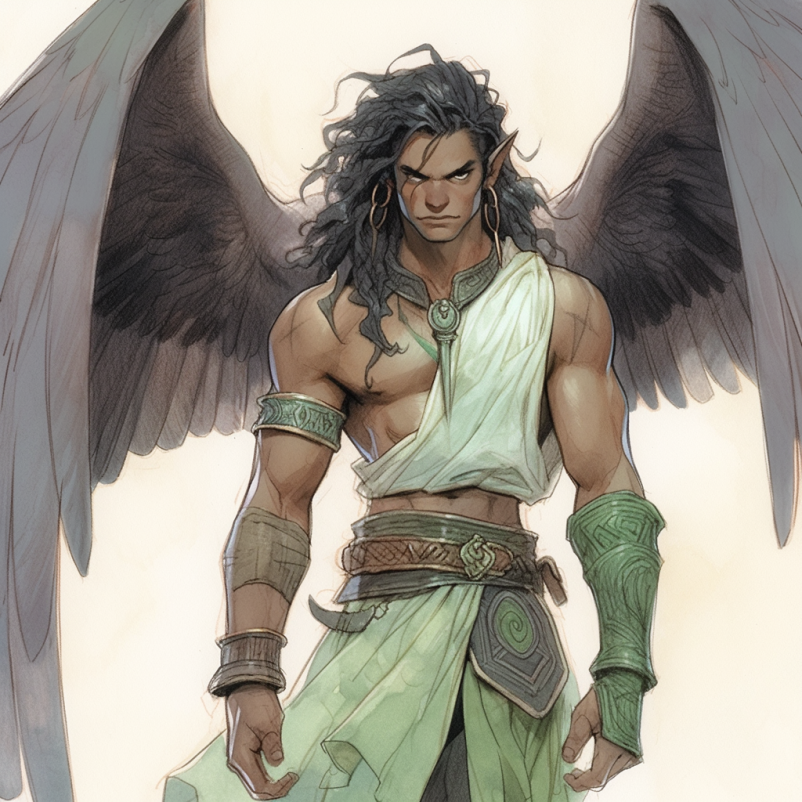
Monadic deva are angelic beings from the Upper Planes who are responsible for travelling to the Elemental Planes, bearing messages of diplomacy, promises or demands from their patron powers. While planewalking on the Inner Planes they monitor the state of morality.
Stats: [ D&D 2e | 3e | 5e ] [ Pathfinder 1e | 2e ] Planescape Monstrous Compendium [2e] p5,7; Bestiary 2 [PF1e]; Bestiary 2 [PF2e] p14
Animental, Fire
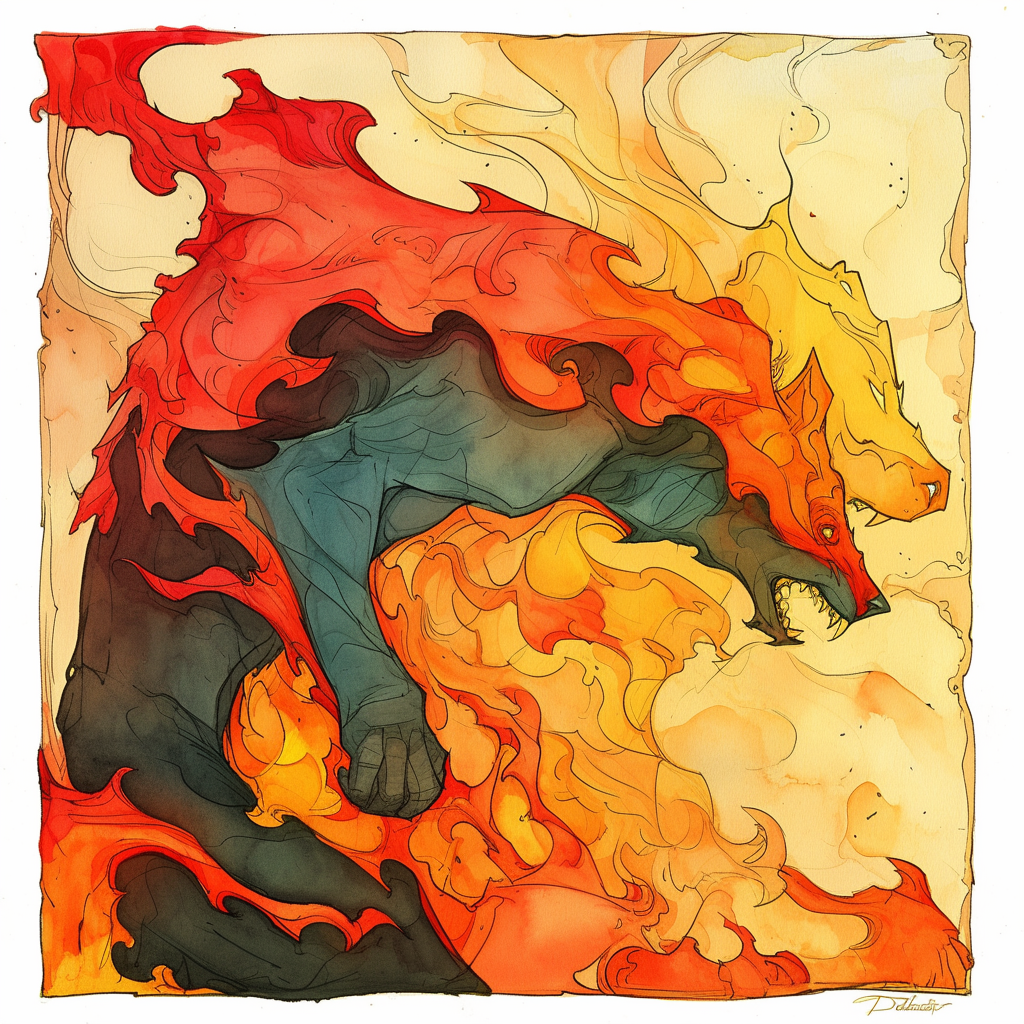
The animentals are basically the animals of the Plane of Fire; creatures made from pure flame that lack the self-aware intelligence of fire elementals themselves. They appear in a variety of forms which remind planewalkers of creatures they’ve seen on the Prime—flame bears, inferno crocodiles, fire elephants. Its not clear whether these varied forms all belong to one type of animental, whether they change their shape as they please or whether they specialise their forms to fit the particular environmental niche in the Crematorium.
Stats: [ D&D 2e ] Planescape Monstrous Compendium Vol. 3 [2e] p14-15. Pathfinder has the Element Infused Creature template, which lets you turn any creature into a fire version with this monster template. [ Pathfinder 1e ] Planes of Power [PF1e] p56-57
Azer
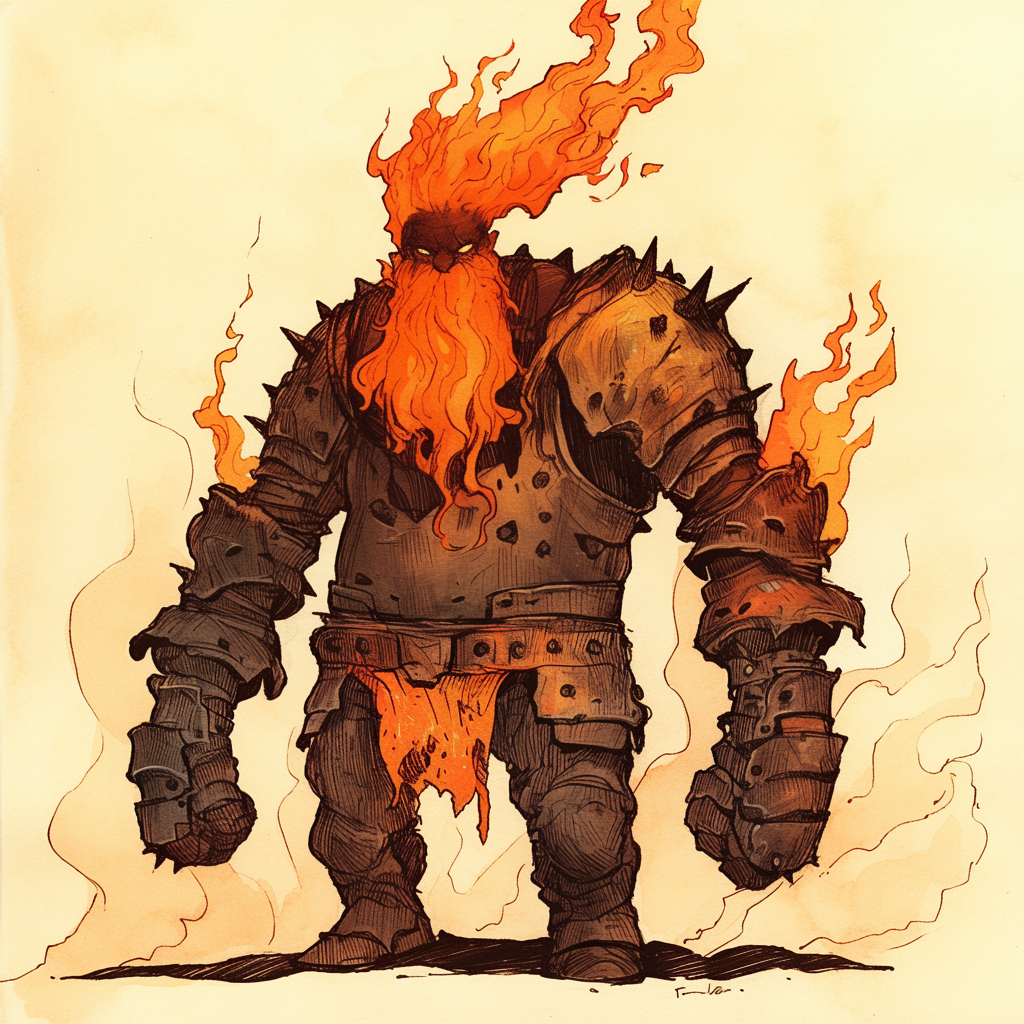
Now azers may look like they belong in the Plane of Earth—to a casual onlooker they resemble heavily-armoured dwarves with flaming manes. But the metal “skin” of the azers is merely their outer shell, for their true body is made of living fire inside. It is believed that azers were created as slaves to the Primordials, but then broke free. This, and the constant threat of subjugation from other races, has led this generally peaceful race to develop a strong code of law that takes precedence over any social hierarchy (at least in theory).
Azers are master metalworkers, and forge craft forms an essential part of their culture. When it is time for an azer to reproduce, they sculpt a body from an alloy (the exact composition of this alloy is unknown, but it mostly includes fyrite with some platinum and other compounds) through the course of many months and then breath a portion of their own essence into this mould. But building themselves a second body isn’t the only thing azers can accomplish; they are among the best smiths in the entire Multiverse. And not only smiths—azer claim that it was they who built the City of Brass itself, although, if that was true, the efreeti would never admit it.
Stats: [ D&D 2e | 3e | 5e ] [ Pathfinder 1e | 2e ] Planar Adventures [PF1] p136; Bestiary 2 [PF1e] p39
Bat, Fire

One of the strangest things throughout the Inner Planes is the fire bat. These tiny pests are flaming batlike creatures, who use propulsion to assist in flight. They are vampiric pack hunters (although not undead), and will drink blood from any creature they can manage to bite—most often from fire whales and striders. But here’s where any similarities end with the bats of the Prime. After consuming blood, fire bats begin a grotesque process of splitting into two separate creatures, with no memories of their parent. Blood is the only thing fire bats consume, although they only need it for preproduction, and can live without food seemingly indefinitely. Oh, and they’re also immortal—slain fire bats simply reappear in other places of the Plane of Fire as a ball of flame that grows into an adult bat after a couple of weeks. Fire bats are a true mystery—no one knows the secret to their revival. Many believe that they are animentals who’ve managed to evolve into a new species—not unlike how human souls became powerful genies. Genies, however, aren’t immortal. Inner Planar scholars of the Fraternity of Order (some say, along with rilmani and aeons) are privately concerned about the threat of mysterious fire bats eventually engulfing the plane, but Fire natives aren’t very concerned by it—they mostly view fire bats as food or pets, or competitors, in case of flame swallows occupying the same caves and trees as fire bats.
Stats: [ D&D 2e | 3e ] Inner Planes [2e] p10,16,45; Planescape Monstrous Compendium Vol 3 [2e] p4,8,10,42-43,46 (43); Monster Manual II [3e] p102-103 (103)
Cinder Brute
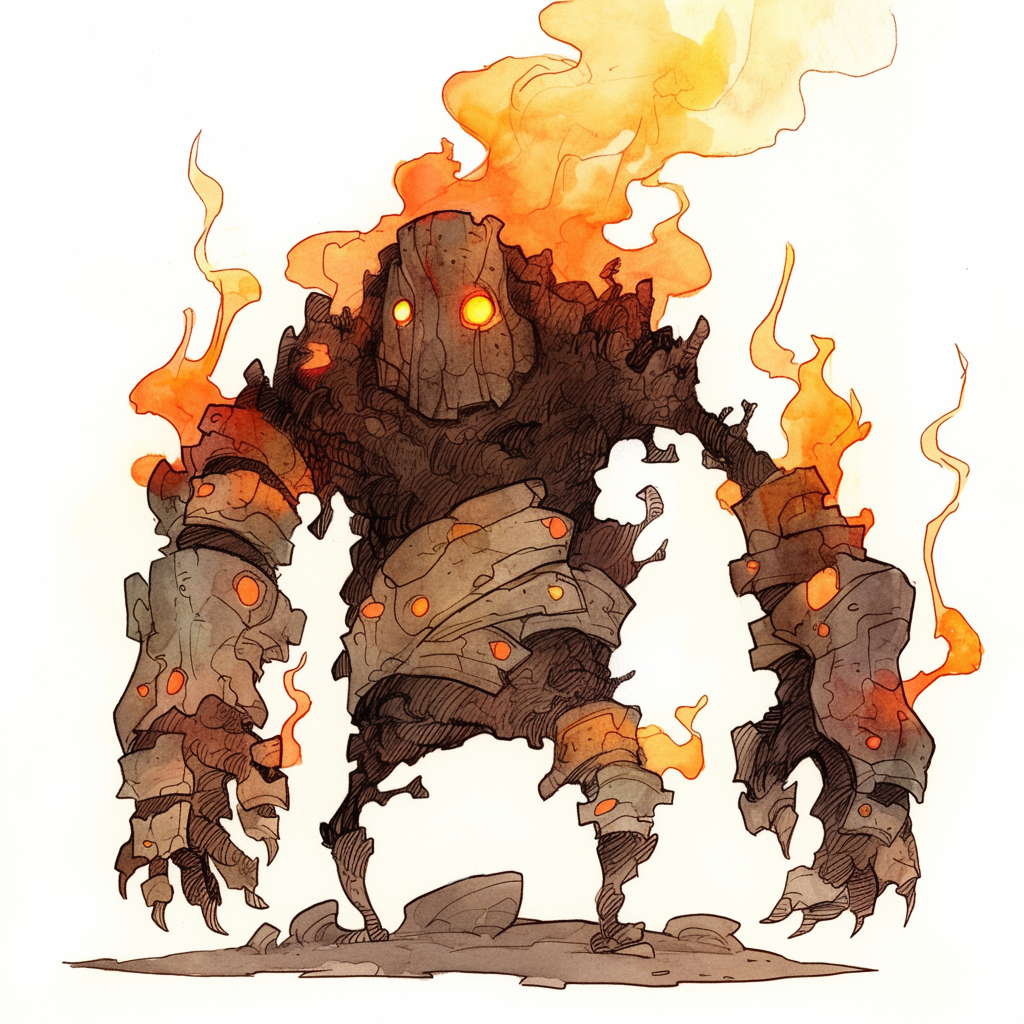
These creatures toe a fine line between Elemental Fire and Quasi-Elemental Ash. Cinderbrutes are squat creatures of hot coals and ash, who live in the Cinder Wastes. Being sandwiched between quite unlikable fire elementals and outright hostile ash quasielementals would make a berk look for any kind of opportunity—and cinderbrutes found one advantage to their situation. In the Cinder Wastes, iron weapons and shields can exist without softening, while still remaining blisteringly hot. Cinderbrutes collect bits and pieces of metal wherever they can find them, bring them closer closer to Core Fire to work them, and then return with new gear. These weapons and armour are poor in quality and uglier than a dead gehreleth, but cinderbrutes hold onto them as relics—after all, it’s very hard for them to acquire even little of metal that they do have. This also means that they’re willing to kill for iron, although if a blood gives them metal gear as a gift, they might find cinderbrutes approachable, even endearing. Cinderbrutes propagate like azers—by sculpting a new body out of ashes and breathing some flames into it. However, they need a specific mixture of ashes to do this, so they have to conduct journeys deeper into the Plane of Ash—but not too deep, or their bodies will lose their heat and, thus, life.
Stats: Dungeon Magazine #110 [3e] p86
Combusted
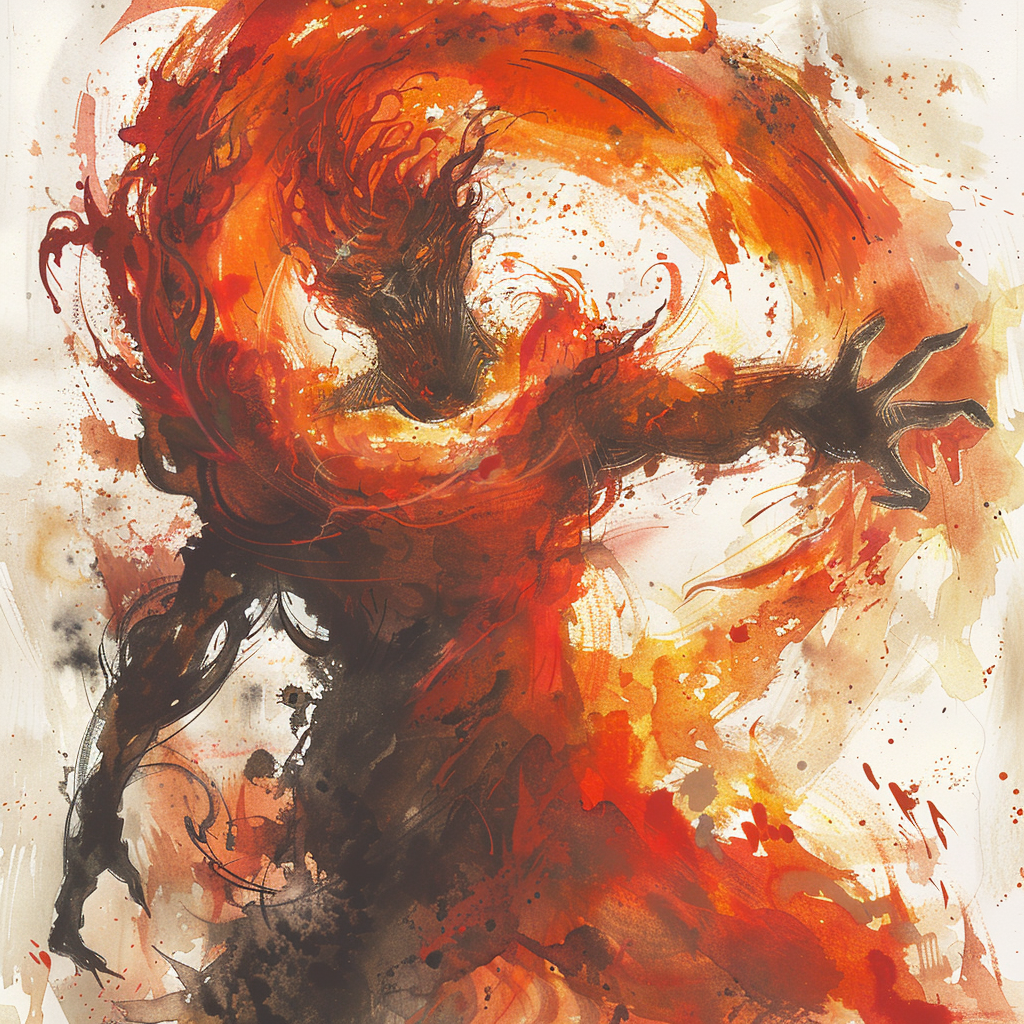
These beings are a raging inferno surrounded by greasy black smoke, wearing charred clothing. They are the victims of spontaneous combustion, or the ferocious flames of hotspots on the Plane of Fire which overcame their magical protection. Somehow their souls clung on to their immolated bodies so hard that they returned as undead.
Stats: [ Pathfinder 1e | 2e ] Occult Bestiary [PF1e] p16 †
Dragon, Wildfire

Some ancient and powerful elementals have taken the form of dragons, and dwell in volcanoes of the Prime and the Core Fire. Also known as elemental fire dragons, these creatures must travel to other planes and ignite wildfires in order to reproduce.
Stats: [ D&D 2e | 5e ] [ Pathfinder 1e ] Homebrew ‡
Drake, Fire
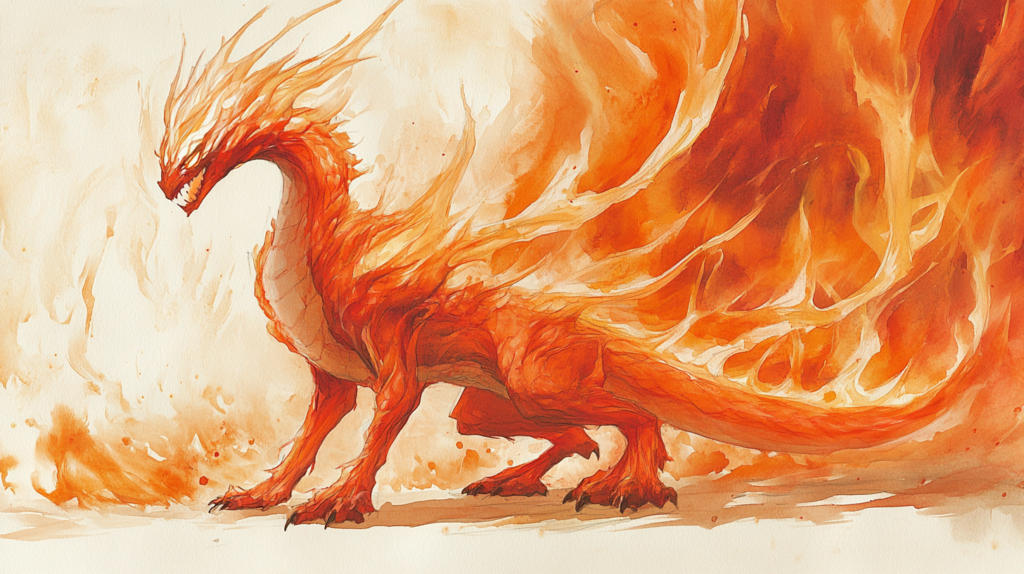
Fire drakes, also called flame drakes, are the most common large predators in the Plane of Fire. They are powerful draconic monsters, who are more bestial than dragons but quite cunning by animal standards. Being descendants of dragons, they inherited their innate knowledge of the Draconic language, powerful wings and fiery breath weapon. All of these is obviously pretty much useless on the Plane of Fire. Fortunately, drakes have their dragon’s share of claws too. Fire drakes are kept and bred by efreeti, who use them as mounts for themselves and genasi.
Stats: [ D&D 2e | 5e ] [ Pathfinder 1e | 2e ] Inner Planes [2e] p44; Planescape Monstrous Compendium Vol 3 [2e] p8
Efreeti
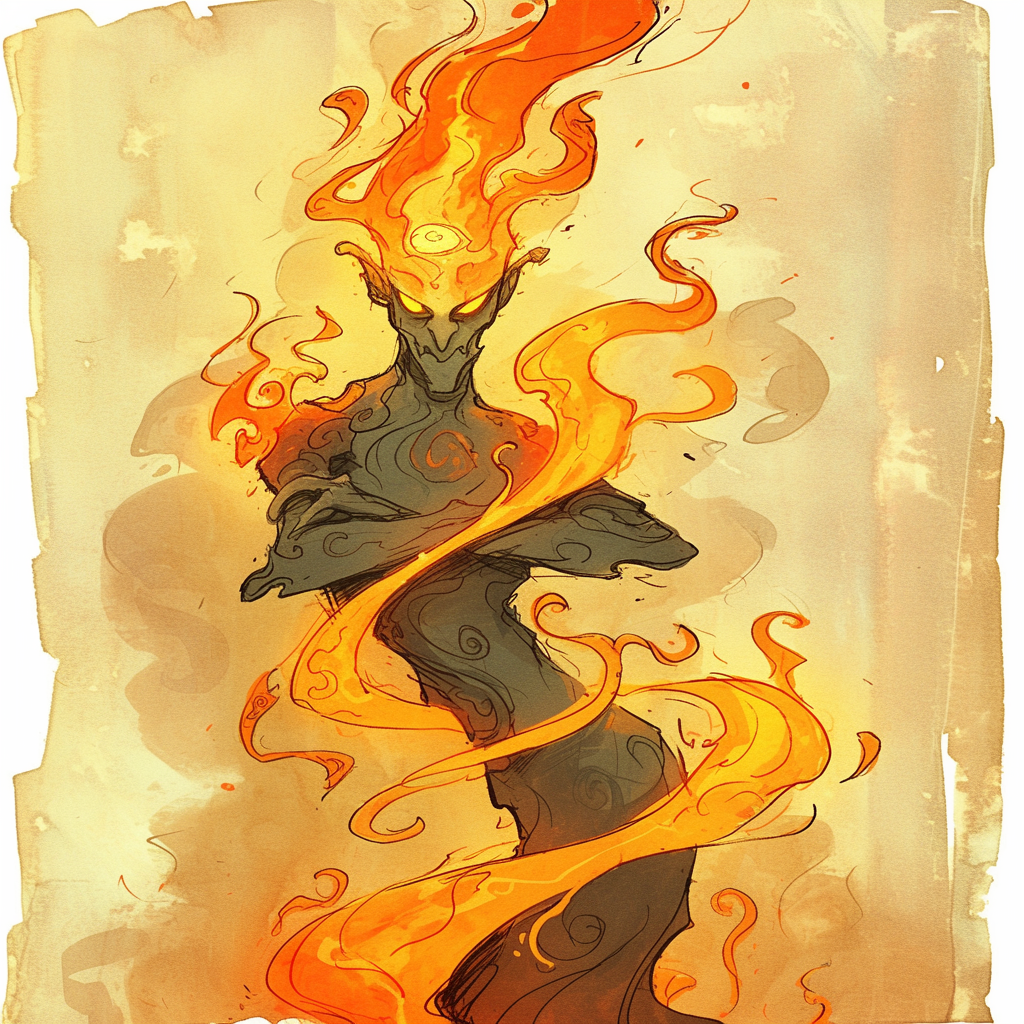
The efreet (efreeti is singular) are giant muscular genies with smoking crimson basalt skin, smouldering eyes and black horns. They’re often mistaken for baatezu by Primes, and this either amuses or offends them, depending on the individual. Best not to risk getting it wrong, cutter.
The efreet are undoubtedly the mightiest of the Great Empires of the Crematorium. They are warmongers and an overall unpleasant bunch, to outsiders and frankly to one another as well. Their City of Brass is an undisputed wonder of the planes though, and it is kept magically cooled, so that it attracts visitors from every plane. It’s still a fearsome heat for most mortals, but one that they can survive without magical assistance if they stick to the shade and drink lots of fluids. Efreetikin and fire genasi serve efreeti—and some of them aren’t even slaves.
See also: Empire of the Efreet [coming soon]
Stats: [ D&D 2e | 3e | 5e ] [ Pathfinder 1e | 2e ] Planar Adventures [PF1] p137. Canonwatch: Efreeti are called ifrit in Pathfinder.
Elemental, Fire
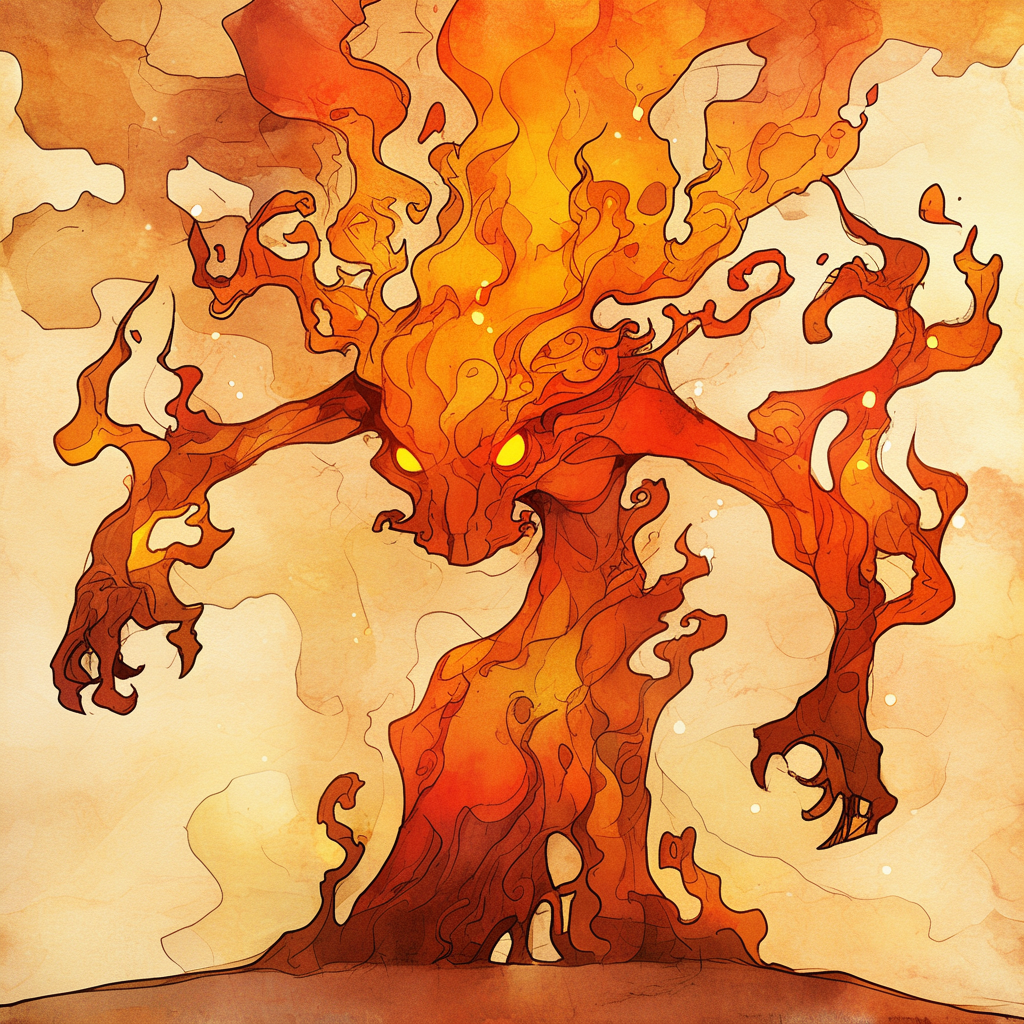
The elementals are sentient beings made entirely from elemental flame, from tiny to enormous. First of all, we must describe common fire elementals. These creatures are disembodied spirits that use bodies of purest fire to manifest themselves. They do not require food or sleep, and in their own environment they can effortlessly glide through fire in any direction. Elementals can harden any part of themselves if the need arises, and this need arises quite frequently. [Rule: In its home plane, if the fire elemental of any kind so desires, its melee attack can deal bludgeoning damage instead of fire]
See, the fire is born in conflict—from striking flint against steel or match against the box and so on—and, in a sense, it is the conflict itself. As the very atoms of fire rub against each other in their crazy dance, so different races of the Plane seen predestined to wage constant wars against each other. Neutral fire elementals would like to live their lives in quiet contemplation, but every once in a while even they become entangled in something.
One of the major conflicts of the plane is the war between the forces of Imix and Zaaman Ruul. Well, it was the conflict, until Zaaman Ruul was soundly defeated and went deep into hiding. Pyrophor (elementals of chaos, whose fire constantly changes shapes and state) and Hellfire Disciples (especially horrible elementals, empowered by Elemental Evil) scour the far reaches of the plane in search of forces of Good – Helions (circle-shaped heralds of law and good) and rare Righteous Flames. ‡
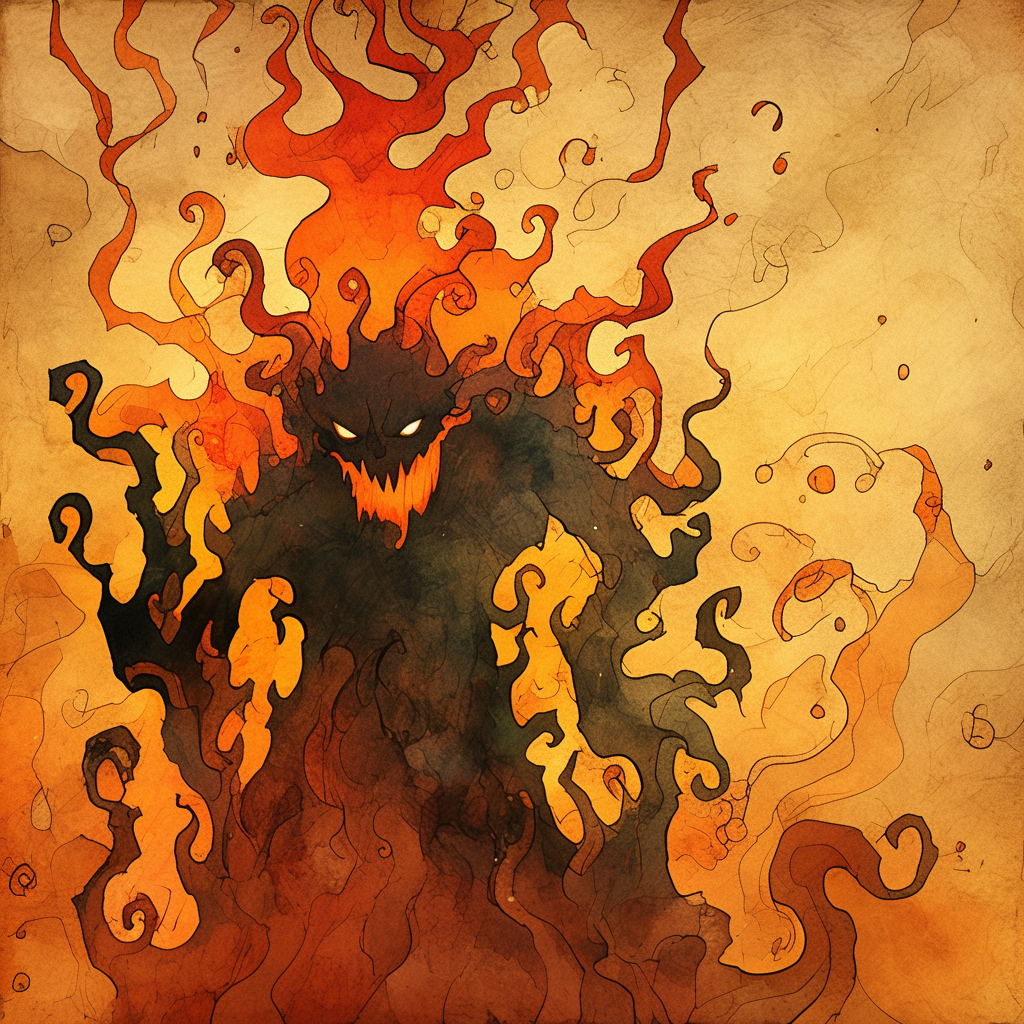
Most fire elementals are, however, staunchly neutral when it comes to philosophical matters of good and evil, or law versus chaos. Elementals are generally known for having quite the incomprehensible culture—and fire elementals are especially poorly understood. When summoned to other planes, they generally go berserk, trying to set as many things on fire as they can. Some researchers explain it as them attempting to shield themselves from surrounding cold, others say something about the innate desire of fire to grow and spread. It is difficult to study elementals in their native environment, but some adventurers have noticed that fire elementals are attracted to materials like asphalt concrete or gypsum plasterboards—materials that can burn, but only barely and as long as they keep contact with fire. They will toy with these materials like a dog nibbling on a chew toy. It seems that fire elementals just enjoy tearing things apart (on a molecular level), and they especially enjoy things that are difficult, but not impossible to dismantle. Efreeti claim that certain elder fire elementals possess extensive knowledge of the alchemy—yet another proof of the aforementioned speculation.
See also: Elemental Empires [coming soon]
Stats: [ D&D 2e | 3e | 5e ] [ Pathfinder 1e | 2e ] Inner Planes [2e] p17,44-45,77; Manual of the Planes [3e] p74; Monstrous Manual [2e]; Monster Manual IV [3e]. Planescape Campaign Setting [2e] DM’s Guide p31; Planescape Monstrous Compendium Vol 3 [2e] p42,93,122; Planewalker’s Handbook [2e] p28; Planar Adventures [PF1] p137; Bestiary 1 [PF1e] p120-127; Monster Core [PF2e] p144. Canonwatch: The ‘holocaust disciples’ of 3e have been renamed as Hellfire Disciples here. True, the original Greek holokauston does mean ‘everything burned’ but using the word now feels insensitive. Righteous flames are homebrew.
Elemental Inferno
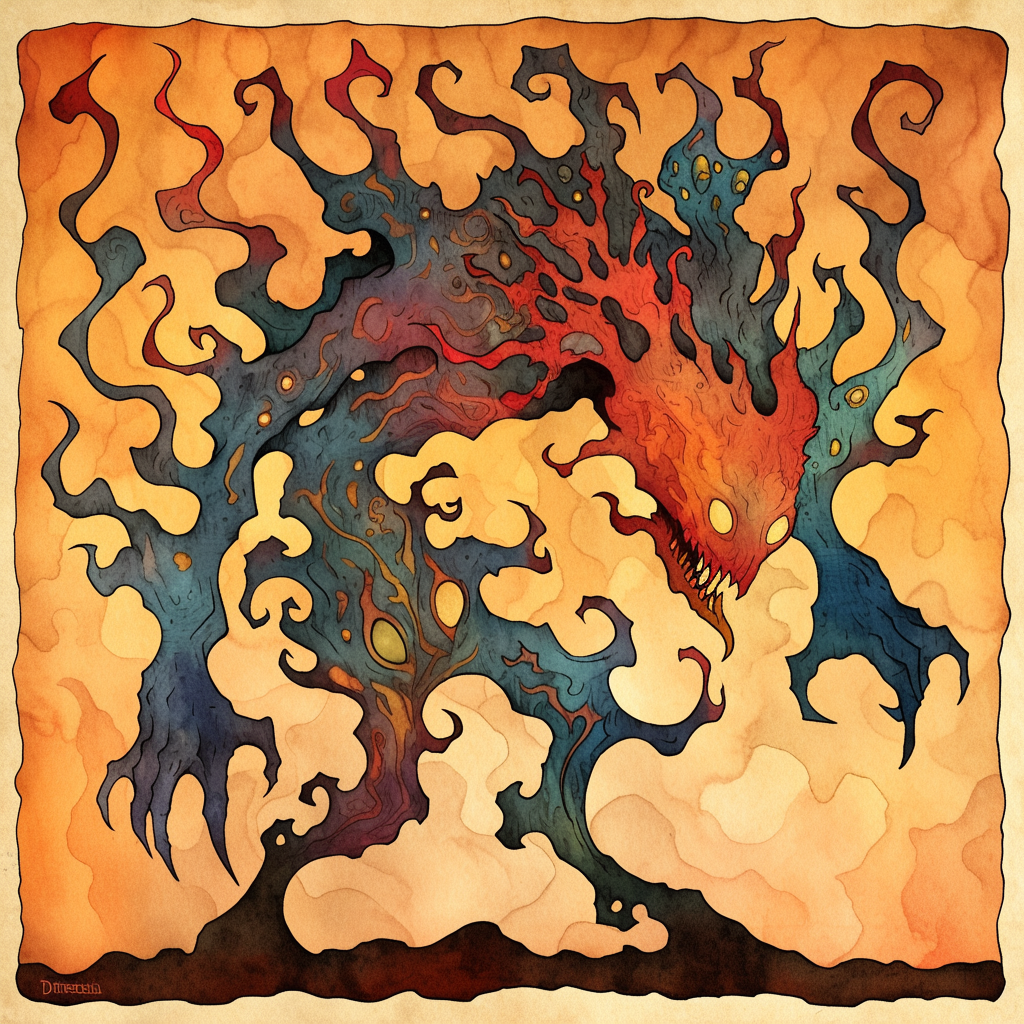
Of course, all elementals are varied—much more so, than a fleshy outsider might realise. But in the heart of flames this is very apparent. In the deep fire there are strange elementals that are particularly unusual-looking—for example the blue fire elemental infernos, who dwell near the Quasi-Elemental Plane of Radiance. As walking conflagrations of unimaginably hot fire, elemental infernos are harbingers of destruction and heedless chaos. More tactical than many elementals, the infernos will set entire cities ablaze to confuse enemies.
Stats: [ Pathfinder 2e ] Bestiary [PF2e] p149; Monster Core [PF2e] p145
Ember Fox
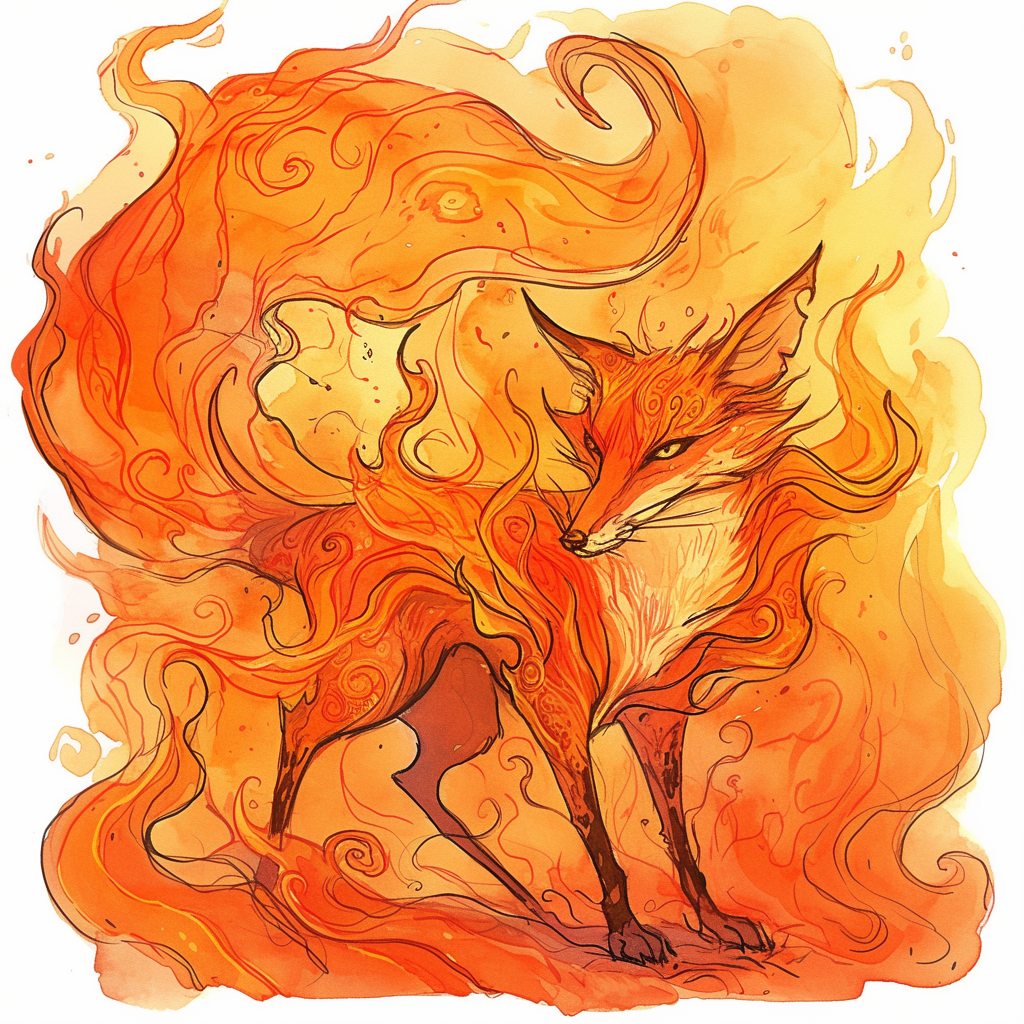
Ember foxes are small carnivores, who hunt scales, waiveras, fire bats and all kinds of other small prey. They are very cautious, since efreeti hunt them for their beautiful fur. However, ember foxes can be tamed – in this case they may even protect their owner from fire-based attacks.
Ember foxes resemble their canid namesakes, save for the flames that make their fur and the tips of their long whiskers flicker and glow
Stats: [ Pathfinder 2e ] Bestiary 2 [PF2e] p110 †
Ember Guard
Stone and brass guardians constructed by the faithful of Imix.
Stats: [ D&D 3e | 5e ] Monster Manual V [3e] p52-53
Emberling
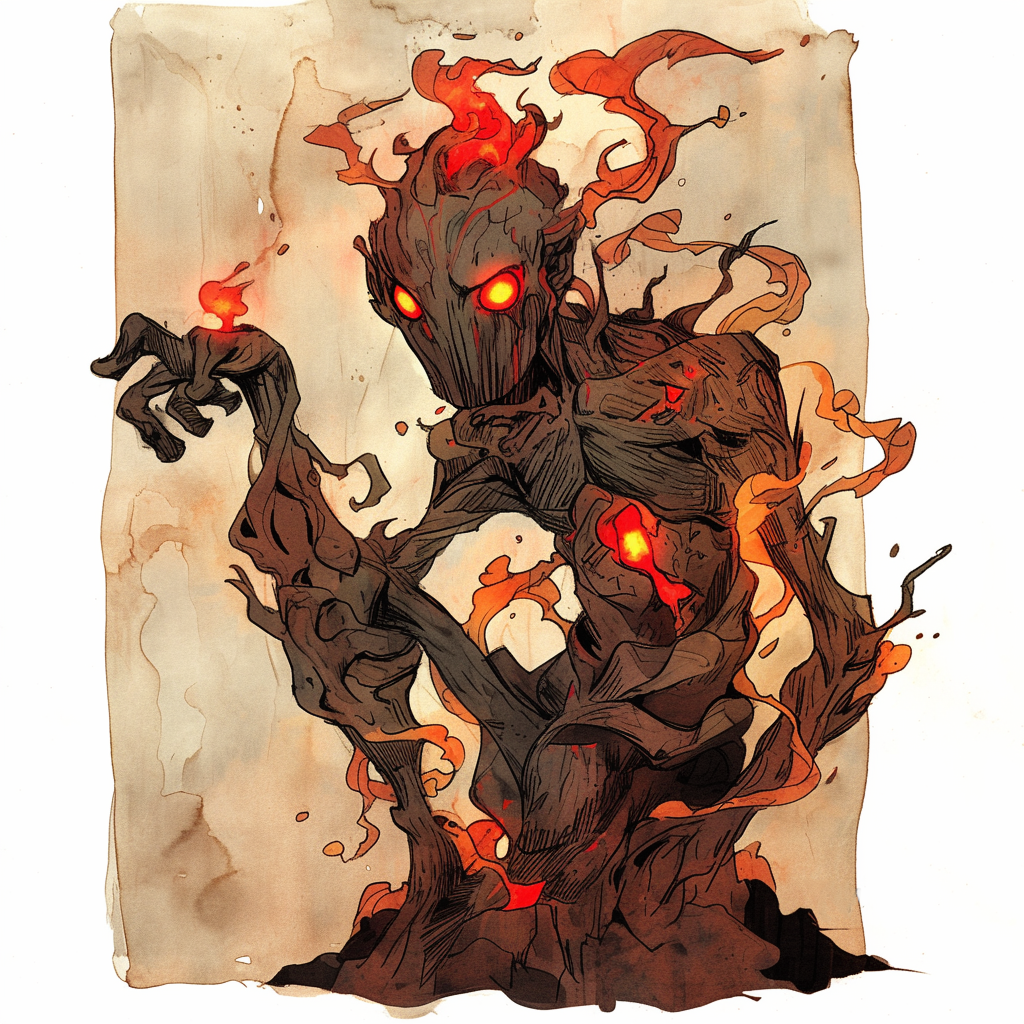
At their core, emberlings are made of compressed fire so tightly packed it looks black. Around this core they are covered by fiery aura, overall appearing like a humanoid-shaped lump of burning coal. Emberlings are quiet and peaceful psionic creatures. Unfortunately in the Crematorium, peace is a rare commodity, and clans of emberlings prefer to hide from their enemies in the Prismatic Frontier. They’re immune to blinding effects of the Radiance and take a great pleasure in observing the ever-changing flames. Due to their psionic powers, emberlings can establish connections with psionists and serve as their elemental stewards.
Stats: [ D&D 3e ] Complete Psionic [3e] p130-131
Entrope
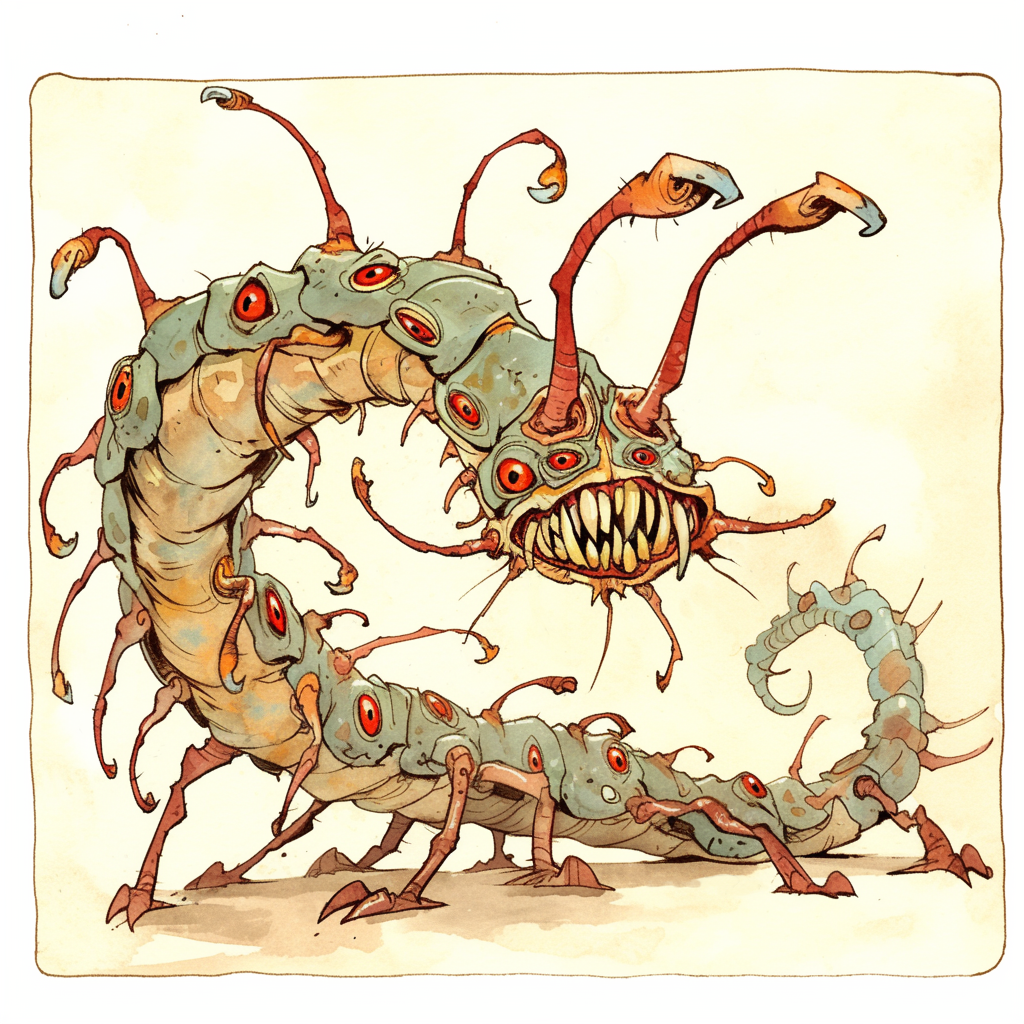
Entropes are terrifying, worm-like creatures engineered by the Doomguard to hasten the collapse of the multiverse’s planar boundaries. Measuring twenty feet in length, their segmented bodies are grotesquely adorned with numerous arms, eyes, and mouths. At least one pair of arms ends in massive claws, while a prominent mouth is filled with razor-sharp teeth. Designed without aesthetic consideration, entropes are living embodiments of entropy itself, with a form reminiscent of a gibbering mouthers crossed with a monstrous centipede. Despite their intelligence, they lack the ability to communicate.
Created to dissolve the barriers between the Inner Planes, entropes feed on the fabric of reality, introducing bubbles of foreign elements into alien planes. This process weakens the planar borders, advancing the Doomguard’s ultimate goal of merging all elements into a chaotic whole. The first batch of entropes escaped Doomguard control and now roam freely across the Inner Planes, indiscriminately consuming planar boundaries and wreaking havoc. While a second batch is kept under stricter supervision, the Doomguard has embraced the chaos unleashed by their creations. Entropes exist solely to accelerate entropy and destruction, making them relentless forces of annihilation with no ecology or purpose beyond their creators’ grim vision for the multiverse.
Stats: [ D&D 2e ] Planescape Monstrous Compendium Vol. 3 [2e] p38-39
Fire Minion
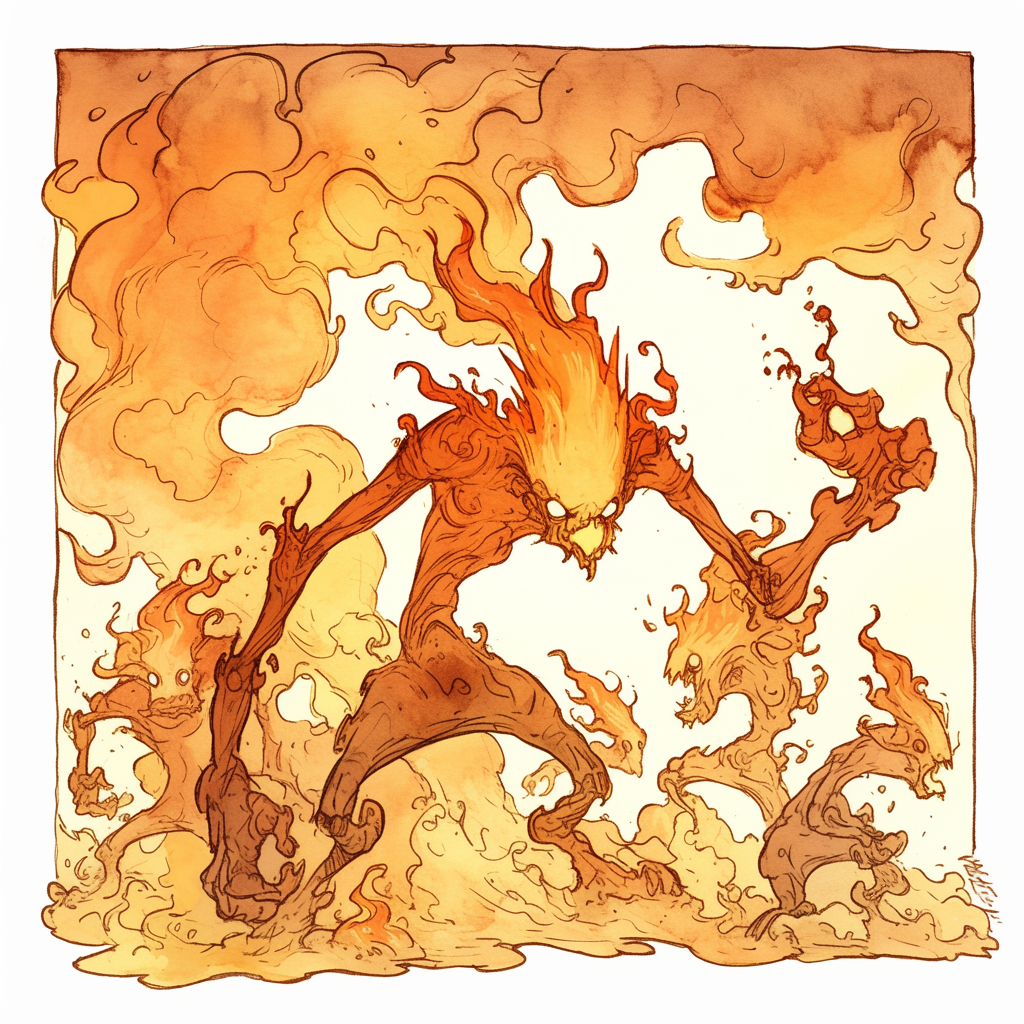
Fire minions are freewilled, and generally wicked, fire elementals who recognise salamanders as their masters. These creatures are made of a heavier kind of flame, perhaps due to the addition of some other elements, or unknown magic. They can become soft like molasses or hard as human body. Fire minions seem to love to fight, and are always trying to conquer other lands—however they also know that they can’t compete with efreeti or salamanders. So, they often become mercenaries for salamanders and firenewts, who build outposts on the Prime Material Plane. Being elementals, they don’t even require any payment and work only for the possibility to visit other planes. It isn’t clear how fire minions come into being—some say they appear only from fires that burned something new, something that hasn’t been on fire before—hence why they so strongly desire to invade the Prime.
Stats: [ D&D 2e ] Inner Planes [2e] p44; Planescape Monstrous Compendium Vol 3 [2e] p8,93; Planescape Campaign Setting [2e] DM’s Guide p31; Planewalker’s Handbook [2e] p28
Firenewt
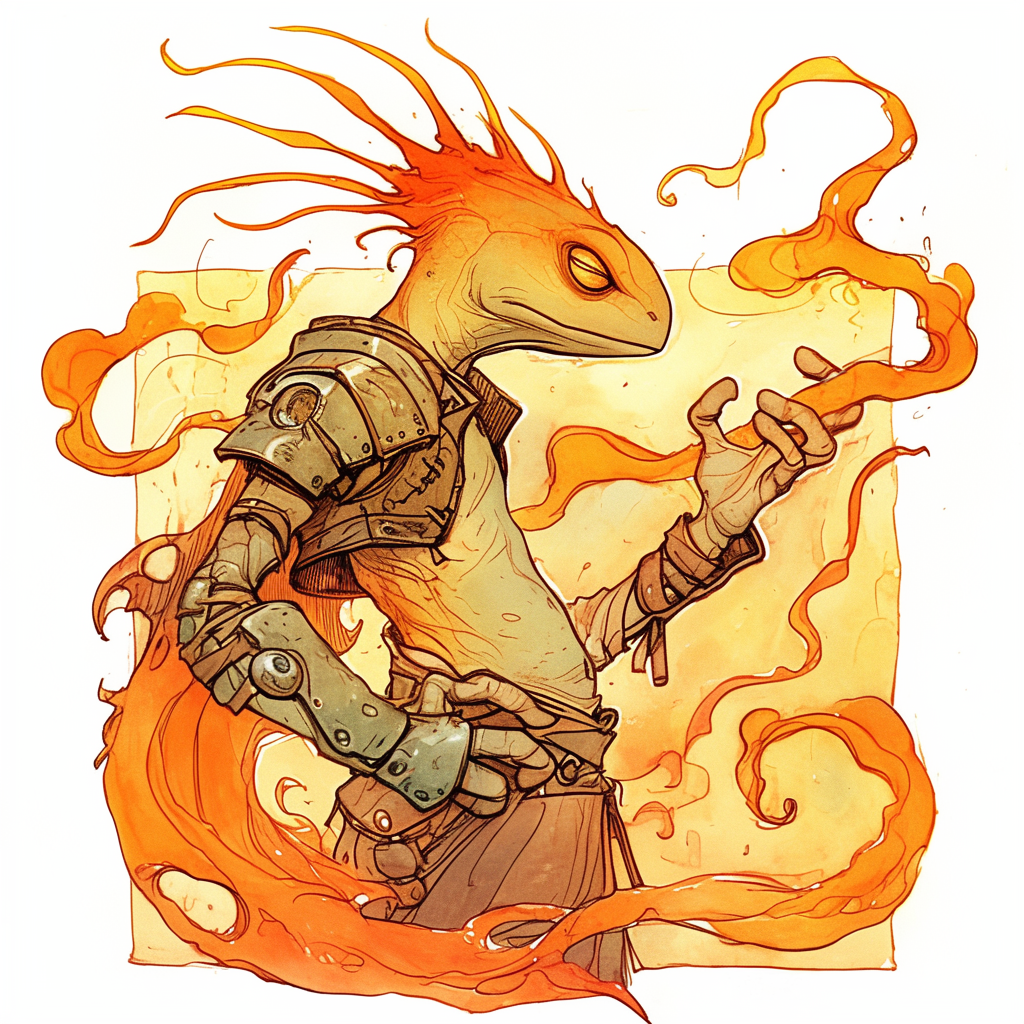
Firenewts (also called salamen) can barely compete with efreeti or salamanders, but they make up for this through their numbers, craftiness and their willingness to ally with different factions from Imix and Kossuth to azers and harginn. Vast armies of firenewts riding great striders claim territory on the more solid firelands, aggressively challenging intruders. Firenewts lay many eggs at once at the bottom of the fire ocean, though if they have access to water pockets or portals to other planes, they prefer to incubate them in near-boiling water. See, while for most firenewts water is naturally poisonous, those of them who were exposed to it during their egg and larval stages, develop resistance. Firenewts are famous for domesticating giant striders, but flame snakes, fire drakes and firetongue frogs sometimes become their pets too.
Stats: [ D&D 2e | 5e ] Inner Planes [2e] p45; Planescape Monstrous Compendium Vol 3 [2e] p8; Dragon Magazine #257
Fire Myrmidon
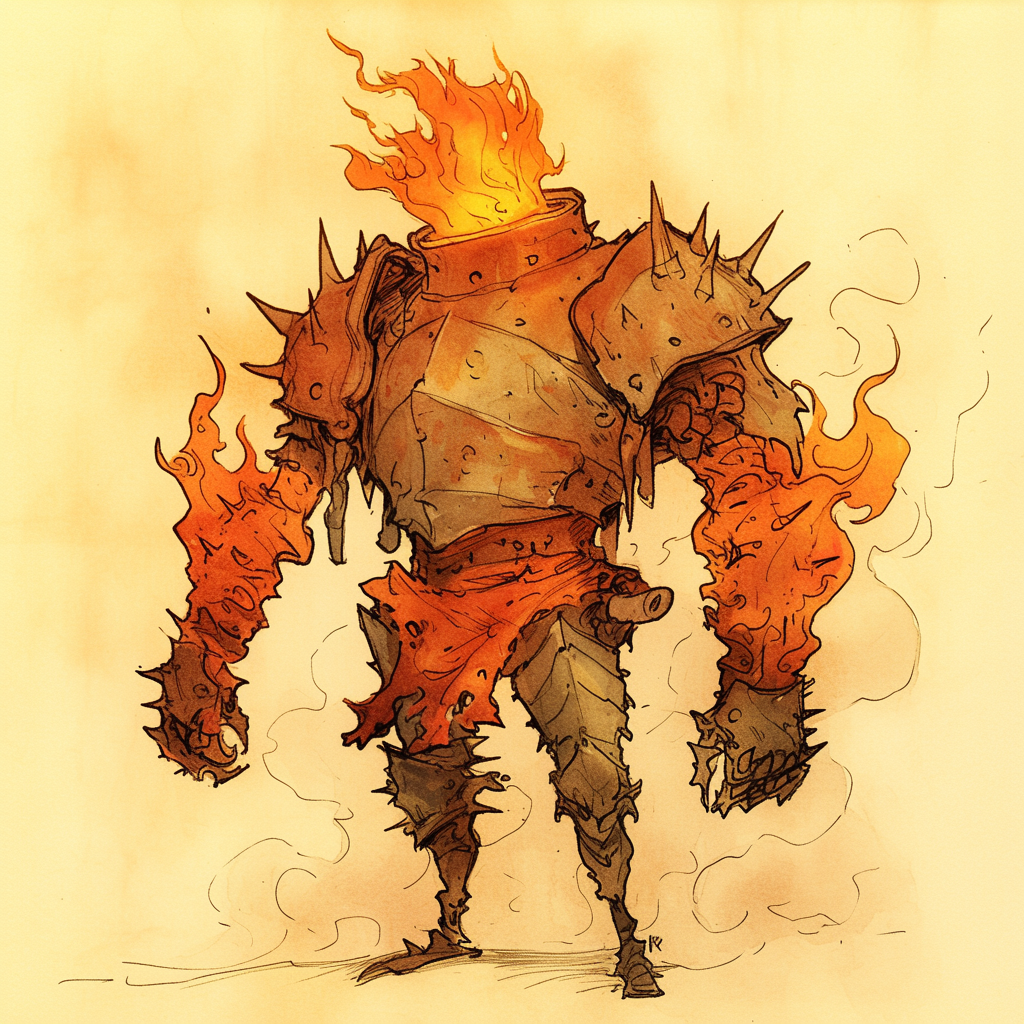
Myrmidons (called by some, incorrectly, elemental archons) are elementals who were subjugated by spellcasters and then encased within magical armour. They’re often mistaken by Primes and Outer Planars as azer, but fire myrmidons are different. Perhaps owing it to the natural inclination of fire to spread, some fire myrmidons that were set loose didn’t abandon their shackles, but adopted them. As another race of warriors and mercenaries, fire myrmidons intermingle with other communities, searching for creatures who are able to create more elemental myrmidons. Unlike azers, fire myrmidons are still common elementals, but unable to reproduce. So, they recruit free elementals to their cause, peacefully or through force. But myrmidons seem to have no endgame—they are but soldiers, and their magical programming makes them do what they were made for, which is to serve as warriors under efreet and azers. Fire minions treat myrmidons as rivals, as the latter are far more valued by the high-ups.
Canonwatch: This is a rebrand of the Fire Archon from D&D 4e. See Dragon Magazine #361.
Firetail; Tshala
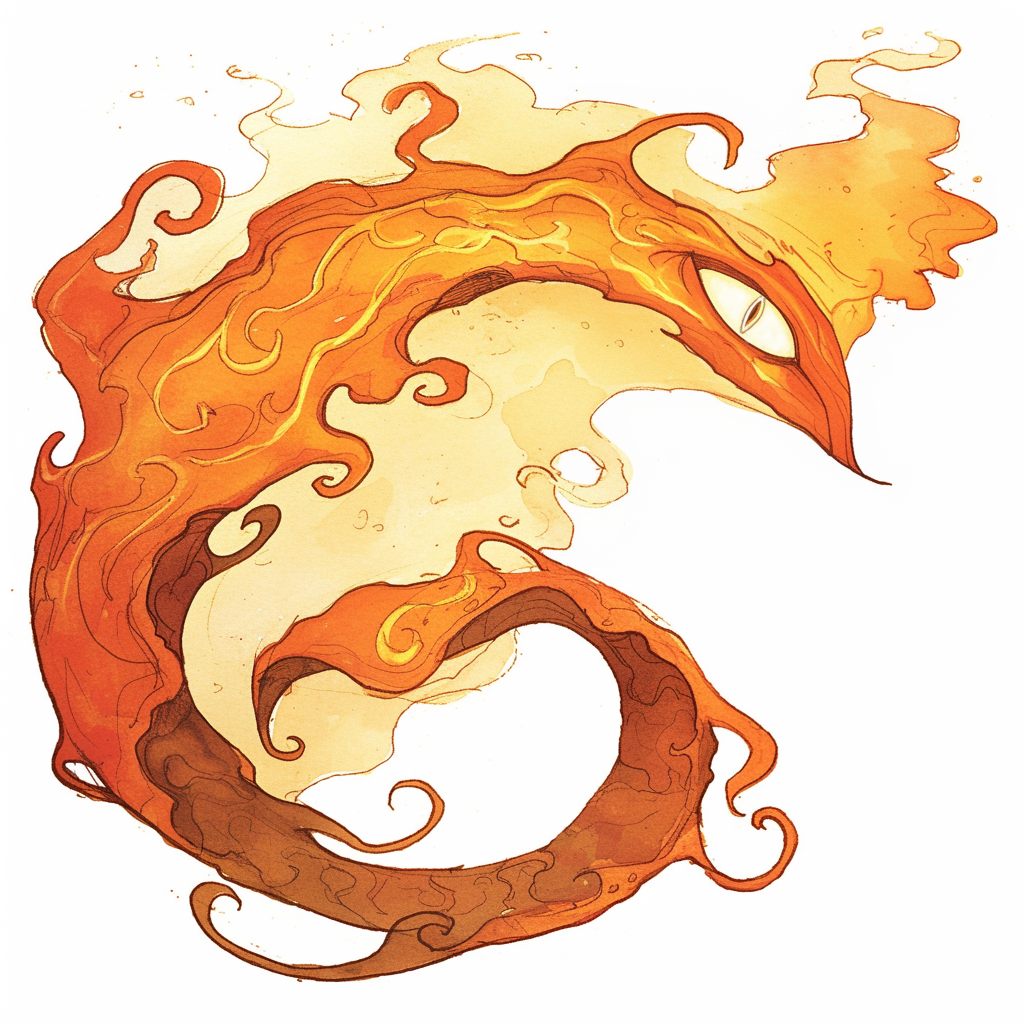
When the Feywild’s frolicsome powers touch the primal forces of Fire, firetails are born. These are living columns made of liquid fire, though they can change their shape and colour as they see fit. Firetails are weirdly sociable, and they can control their flames as to not burn creatures they touch (or, instead, to burn everything around them with white-hot fire). They ignore most other elemental creatures, but attack salamanders on sight (I’d suggest whether this confirms or disproves salamanders’ supposed fey ancestry, is best left for others to decide). Unlike that of many other creatures from this plane, the life cycle of firetails is known. After reaching approximately 400 years of age, a firetail can bud like an ooze would. This needs to occur in a fiery environment—a challenge for those of them who live on other planes, but not for the less adventures fire tails who remained in the Creamtorium.
A tshala is a more powerful kind of the firetail. Some of the creatures are born as tshalas, but most undergo brief metamorphosis after 200 years of living. Tshala gain access to innate magic even as powerful as plane shift. For such intelligent and generally benevolent creatures, firetails have little to no culture (at least none that is noticeable). They wander fey-touched regions and the Prismatic Frontier, avoiding other fire elementals, whom they seem to find brutish. At the same time, firetails seem to enjoy spending time with fey and foreign humanoids, often asking to be taken away from their home plane.
Stats: [ D&D 2e ] Inner Planes [2e] p45; Planescape Monstrous Compendium Vol 3 [2e] p8,21; Planescape Campaign Setting [2e] DM’s Guide p31
Firewyrm; blazewyrm
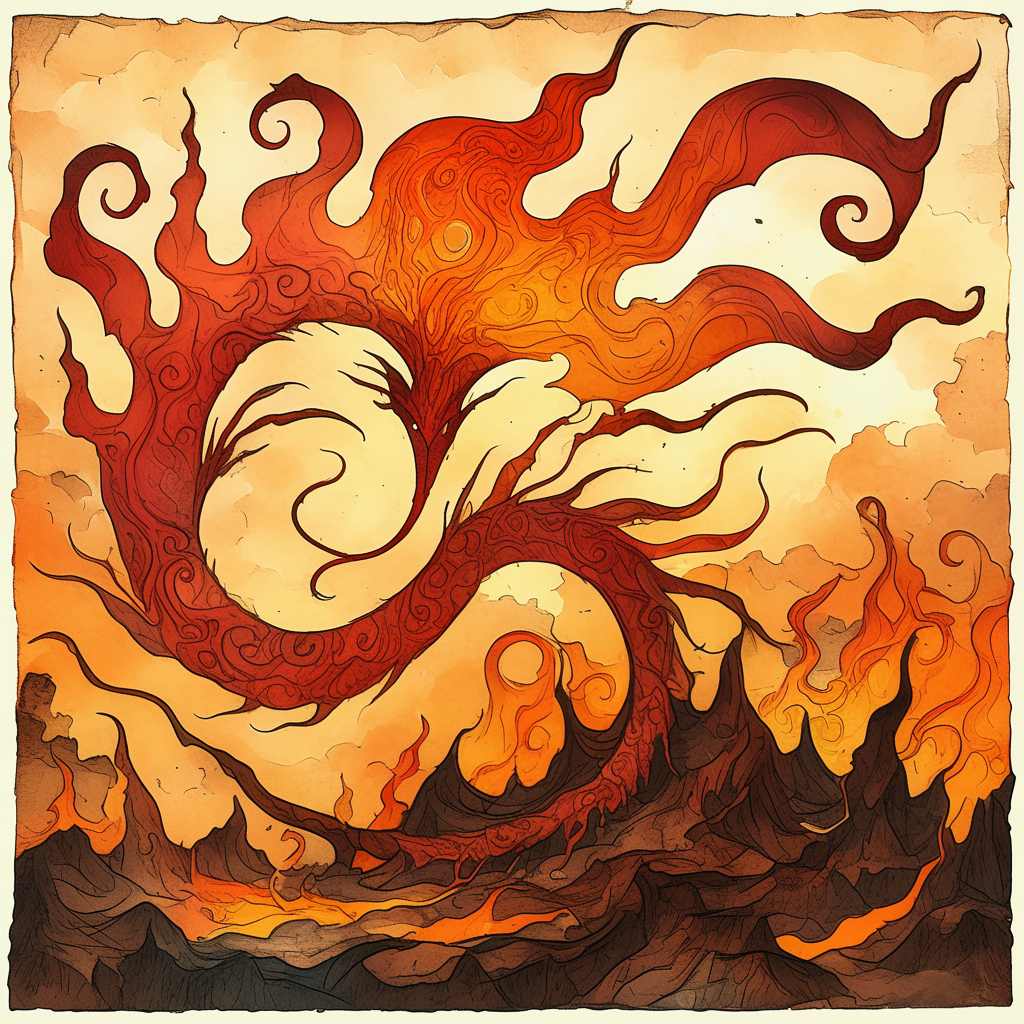
Blazewyrms or firewyrms live deep beneath the surface of the Plane of Fire. They’re said to come from animated breaths—a kind of elemental construct created by dragons, with the help of a special spell. This doesn’t seem far-fetched, considering fire myrmidons were also able to become more than an automaton. Blazewyrms live in burrows they themselves create in tubes of molten lava, and somehow keep stable—no one knows how and why living flames that assume an approximate shape of a serpent would do this. These strange environments often connect to volcanoes on mortal worlds, giving firewyrms access to a wide variety of prey. Perhaps they have some remaining draconic instincts and powers? Regardless, blazewyrms aren’t much smarter than animals. They’ll attack most creatures that aren’t common elementals and seemingly feed on them (why would a full-on elemental need to feed is anyone’s guess). Some races have been known to use blazewyrms as beasts of war.
Stats: [ Pathfinder 2e ] Bestiary [PF2e] p149; Monster Core [PF2e] p144. Canonwatch: Blazewyrms are from Dragon Magic [3e]; firewyrms are from Pathfinder
Flameling
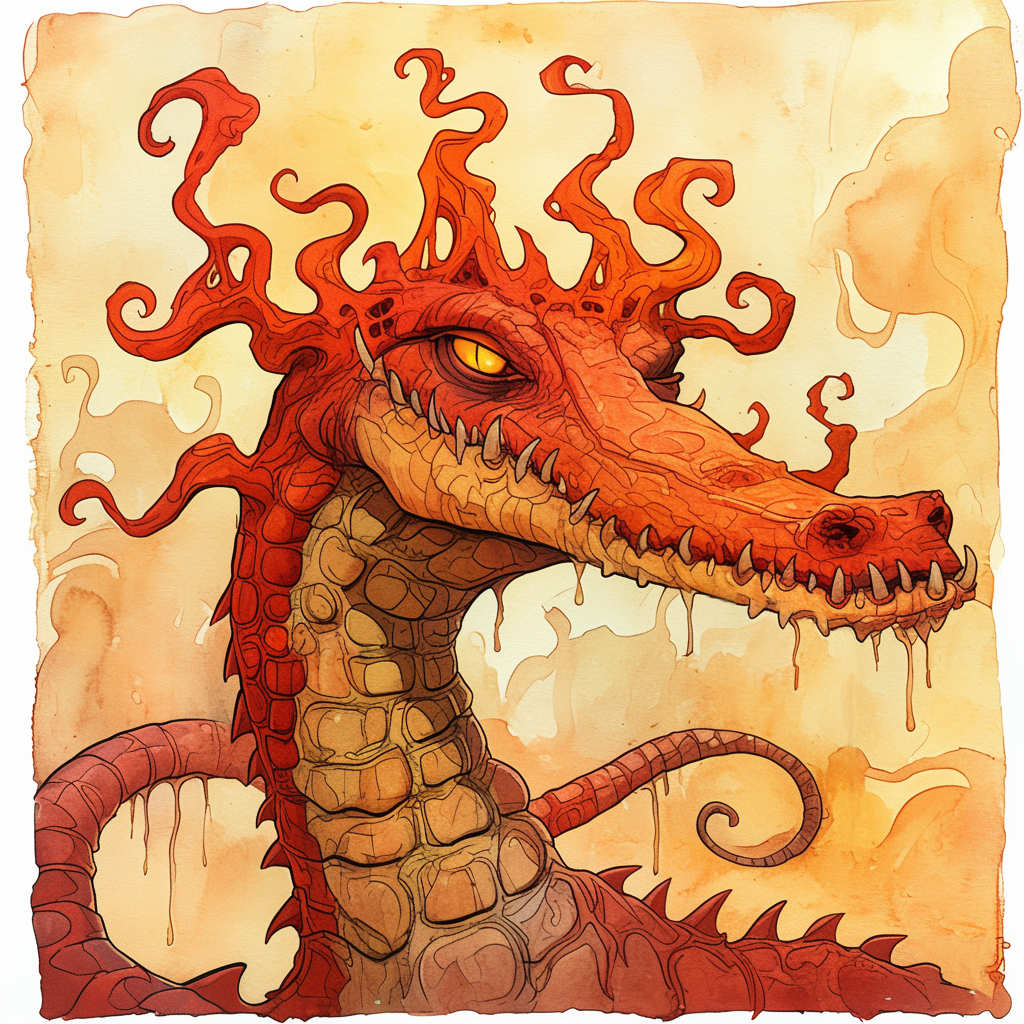
Flamelings, on the other hand, are dime-a-dozen on this plane. In fact, Parallelists consider them to be one of four species of elemental vermin. Flamelings look like small crocodiles with club-like tails and a crown of tentacles. This tentacles are a sensory organ, that lets them detect changes in the temperature. Normal infravision doesn’t work on the Plane of Fire – it all grows equally bright. But flamelings are adapted to this brightness and can distinguish their slightly colder prey from its surroundings (however, this means that they lose their infravision in colder places – as if they were in the dark). Another function of those sensors is excretion – they ooze excess fire. Flamelings can expel this fire as tiny fireballs and use this as a (frequently ineffective) method of self-defence. Flamelings are semi-aquatic in a sense that they live both in the fire ocean and on solid lands. They are mostly carnivorous, but can eat plants too.
Flamespirit
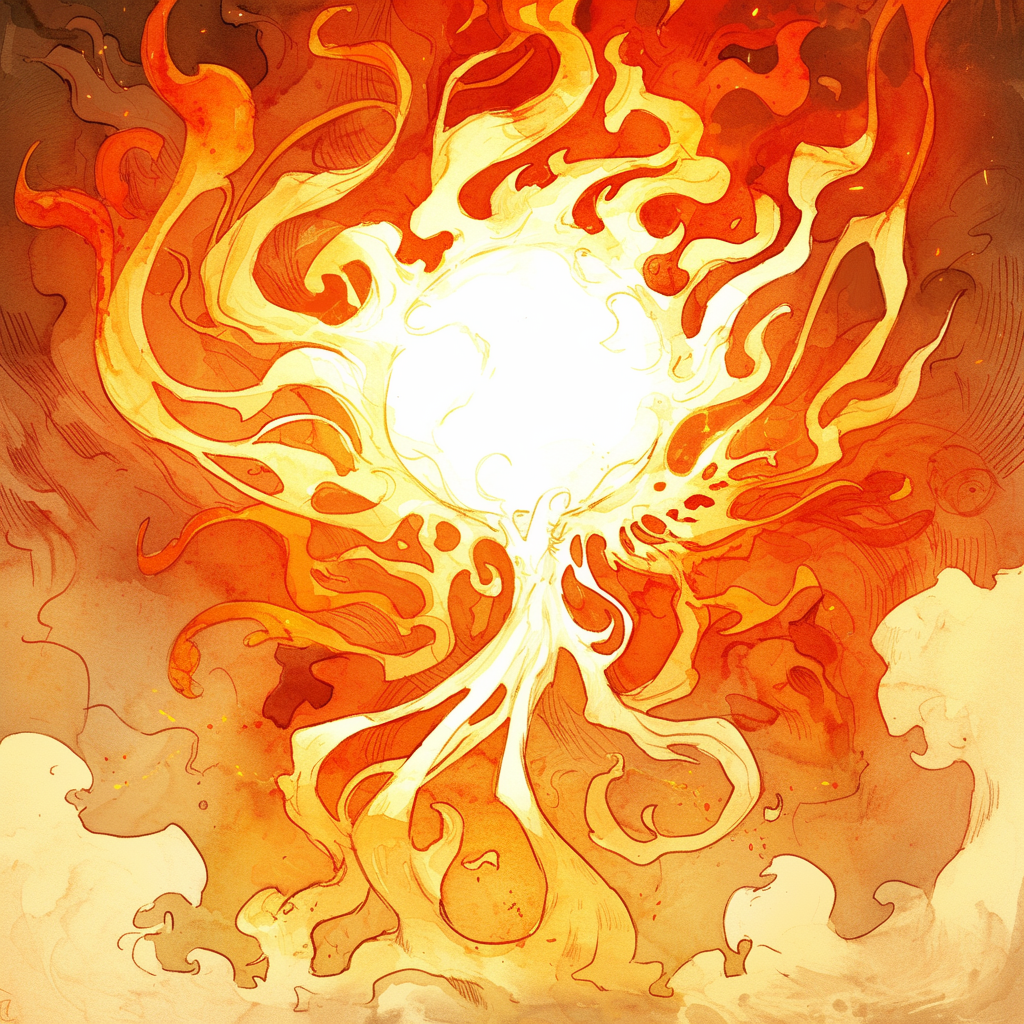
These things look like pulsating balls of fire with protruding flaming tendrils. They are similar in behaviour to fire elementals, although they are able to magically control normal fires. Some sages think flame spirits are some kind of fire elemental, changed through powers of wu jen. Others propose that flame spirits have descended from a specific kind of fire elementals, who have discovered some great alchemical secret (of which today’s flame spirits have no memory).
Stats: [ D&D 2e ] Monstrous Compendium Kara-Tur Appendix [2e]
Frog, Firetongue

This predator is quite more dangerous than a flameling. Firetongue frogs are huge as far as frogs go, enough so that they can prey on ember foxes, fire bats, flame swallows and even young flamelings. Their tongues and skin are covered with the debilitating toxin. It is similar to the venom of flame snakes, but even more powerful. When harassed by creatures, who are immune to poison, firetongue frogs can defend themselves by unleashing a burst of blinding searing light. The slick slime of those frogs protects them from radiant damage of the Prismatic Frontier and Quasi-Elemental Radiance. Firetongue frogs are much smarter than regular amphibians, being on par with monkeys or crows, and some of them willingly serve Imix. They can be sent as envoys of destruction to the Prime Material Plane, although they risk their lives there. Liquid water can wash away frogs’ protective slime and be absorbed through their thin skin, fatally poisoning the frog.
Stats: Dragon #285. Firetongue frogs were mostly mooks for Imix there, here they are more like animals on par with flame snakes.
Fundamental, Fire
A batlike pair of wings, the fundamentals are weakest of the true elementals.
Stats: [ D&D 2e ] Planescape Monstrous Compendium Vol. 3 [2e] p46
Gen, Fire
Small elemental genies who sometimes serve as familiars to sha’ir, helping them to weave their magic. They’re also called efreetikin by some cutters.
Stats: [ D&D 2e | 3e ] Dragon Magazine #315 p83; Inner Planes [2e] p44; Planescape Monstrous Compendium Vol 3 [2e] p8
Genasi, Fire

(Ifrit, Flame Lord)
Mortals who are plane-touched by Elemental Fire, or have efreet ancestry may be born as fire genasi, or ifrit. The genasi is a playable race in D&D (part human, part efreet) and a versatile heritage in Pathfinder (and can be combined with any ancestry, for example elven or halfling ifrit)
Stats: [ D&D 2e | 3e | 5e ] [ Pathfinder 1e | 2e ] Planewalker’s Handbook [2e] p73-74; Bestiary 2 [PF1e] p160
Giant, Fire
Militaristic giants with flames for hair.
Stats: [ D&D 2e | 3e | 5e ] [ Pathfinder 1e | 2e ] Deities & Demigods [3e] p190-192,200; Inner Planes [2e] p43-44,78; Planescape Monstrous Compendium Vol 3 [2e] p8,10; Manual of the Planes [3e] p91; On Hallowed Ground [2e] p140; Planes of Chaos [2e] Book of Chaos p123-124; Planescape Campaign Setting [2e] DM’s Guide p64
Gnome, Fire
A playable race of gnomes with fire elemental blood who dwell in Dothion and Elemental Fire
Stats: [ D&D 3e ] Planar Handbook [3e] p125-126
Harginn Grue
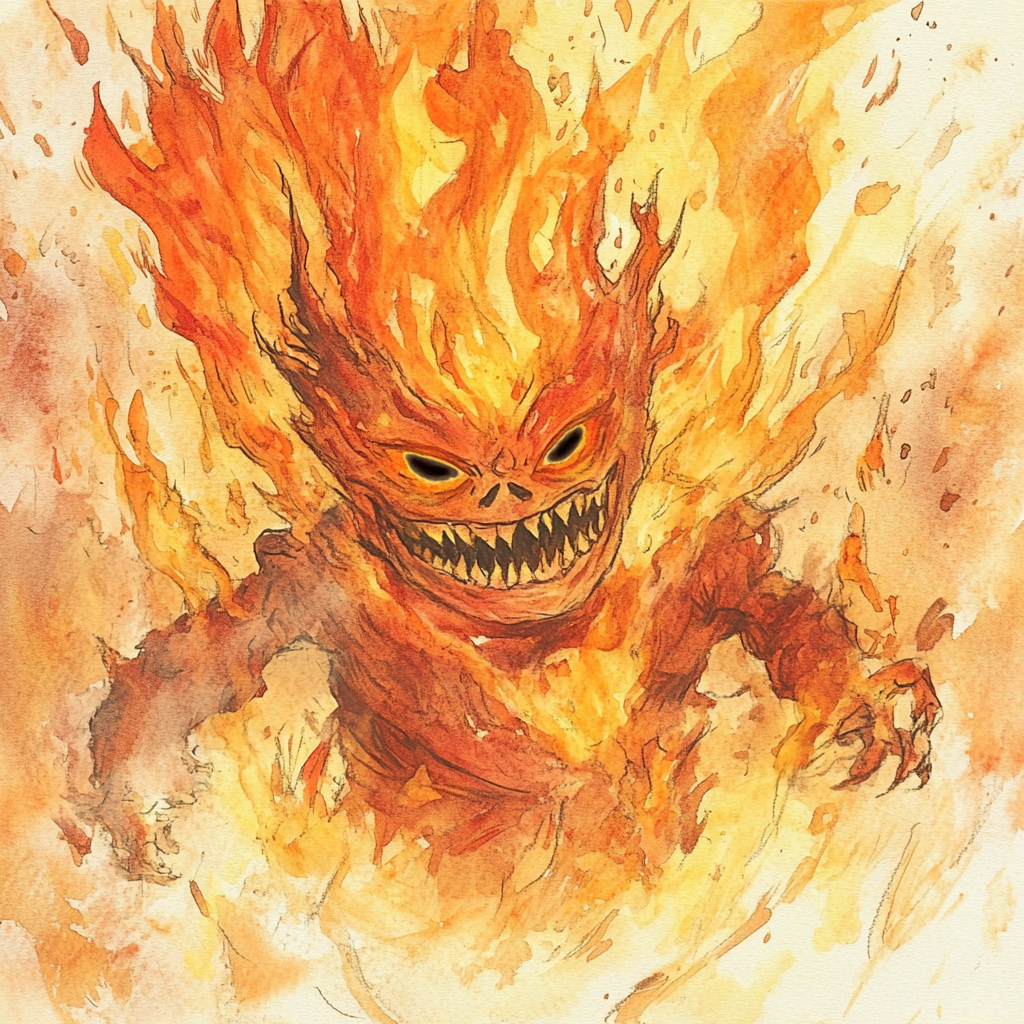
Fire Grue, Flame Horror
Also known as fire grues or flame horrors, grues exist on Elemental Planes as janitors, who seek to destroy and convert any impurity in their element. Fire grues look like humanoids with red or orange skin and jet black eyes, but in times of need they shed this facade, revealing their true form—a pillar of fire, effortlessly fading into the substance of the Crematorium. Through some unknown elemental magic fire grues drink molten metal and eat obsidian, and excrete the pure flames which envelopes them.
Flame horrors are the most active and prolific of the elemental grues. They don’t have the concept of duty that weirds seem to hold. Many harginn serve Imix for a chance to taste other planes, or else they are subjugated by efreeti or wizards who’ve summoned and bound them. Free grue form their own communities, that are organised into guilds of fighters, foragers and so on. Such communities often engage in piracy. One interesting thing about fire grues is their gender. Apparently, their culture recognises male and female gender presentation, even though grues, like most other elementals, do not engage in sexual reproduction. Perhaps they have picked up this cultural habit from efreeti?
Stats: [ D&D 2e ] Inner Planes [2e] p44; Planescape Monstrous Compendium Vol 1 [2e] p50-51; Planescape Monstrous Compendium Vol 3 [2e] p8,93; Planescape Campaign Setting [2e] DM’s Guide p31; Planewalker’s Handbook [2e] p28
Hearth Fiend
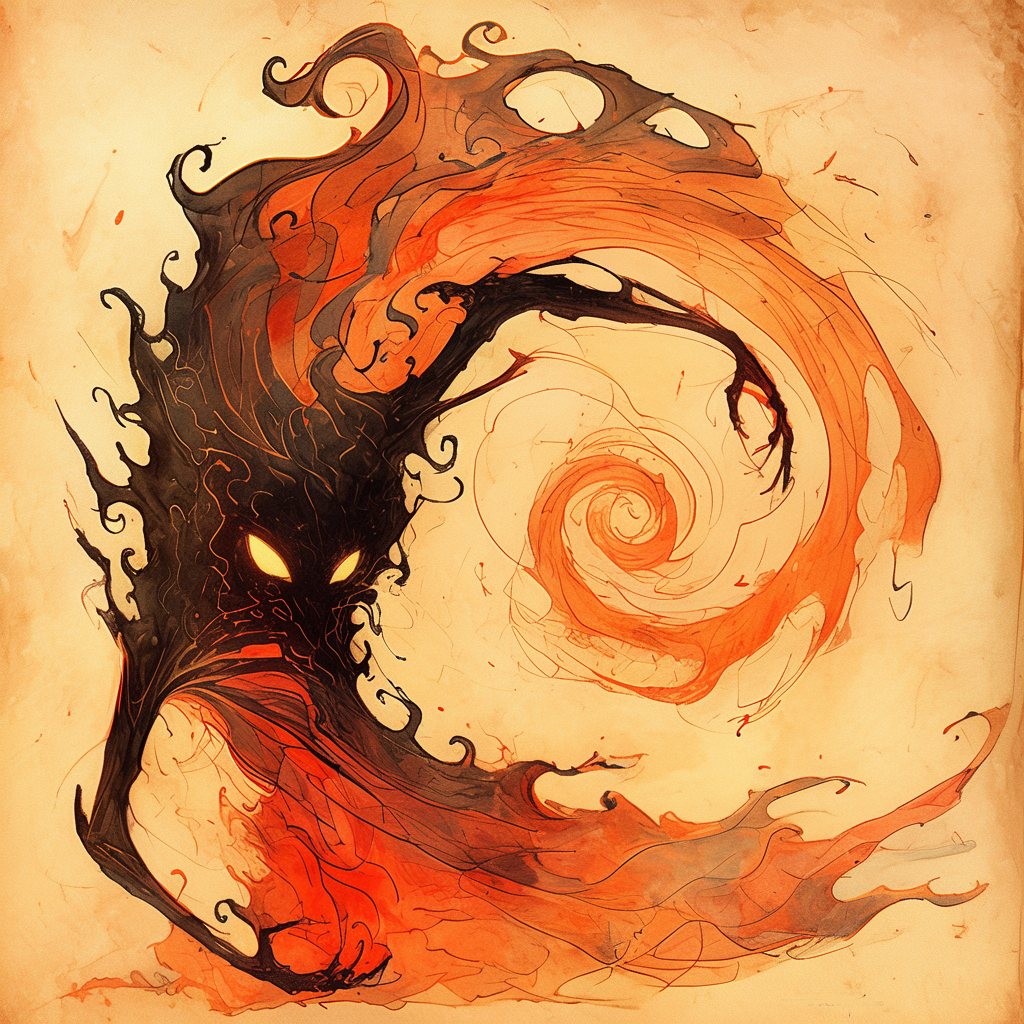
These nasty spirits have no clear origin, and they are suspected to be elementals corrupted by the malevolent powers of the Shadowfell, or perhaps the Negative Energy Plane. Why else would a spirit of fire derive power from burning living beings? Hearth fiends are made of gaseous fire, but unable to harden themselves or fly. They are quite weak and mistrusted by many inhabitants of the Plane of Fire for their hunger for flesh. Unfortunately, hearth fiends also have a number of magical abilities. When a mage on the Prime (or in the Feywild, Shadowfell or Ethereal) casts a spell that draws power from the Elemental Fire, a hearth fiend can sense it and latch onto it. This way, it may be able to piggyback to the Prime, find a convenient fireplace and begin scheming for power and carnage. I swear, there are too many creatures on this plane that just want to leave it, and set fire to somewhere else.
Stats: [ D&D 2e ] Monstrous Compendium Ravenloft Appendix III [2e]
Helian
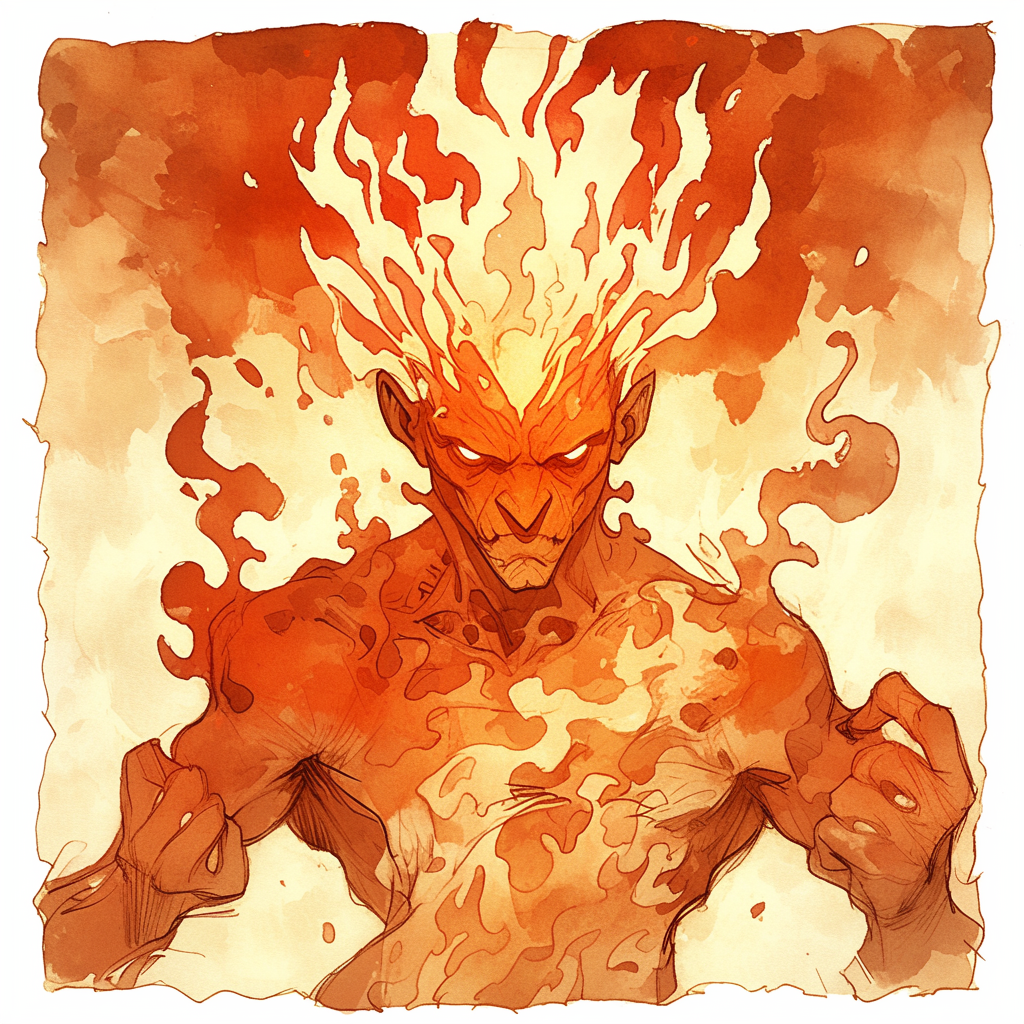
Helians are petitioners of fire powers, who’ve taken on humanoid forms. They’re rarely encountered on the plane, likely being stowed away in their powers’ realms to prevent their early demise, or enslavement by efreeti. However, there are many stories of helians who have fled the Crematorium and taken residence on the surface of suns and stars of the Prime Material, where they live in large tribes, seemingly following no deities at all. They aggressively defend their territories, although living on a sun tends to grant them decent protection from invaders in the first place. Not to be confused with helions.
Stats: [ D&D 2e ] Spelljammer Realmspace [2e] p84
Helion
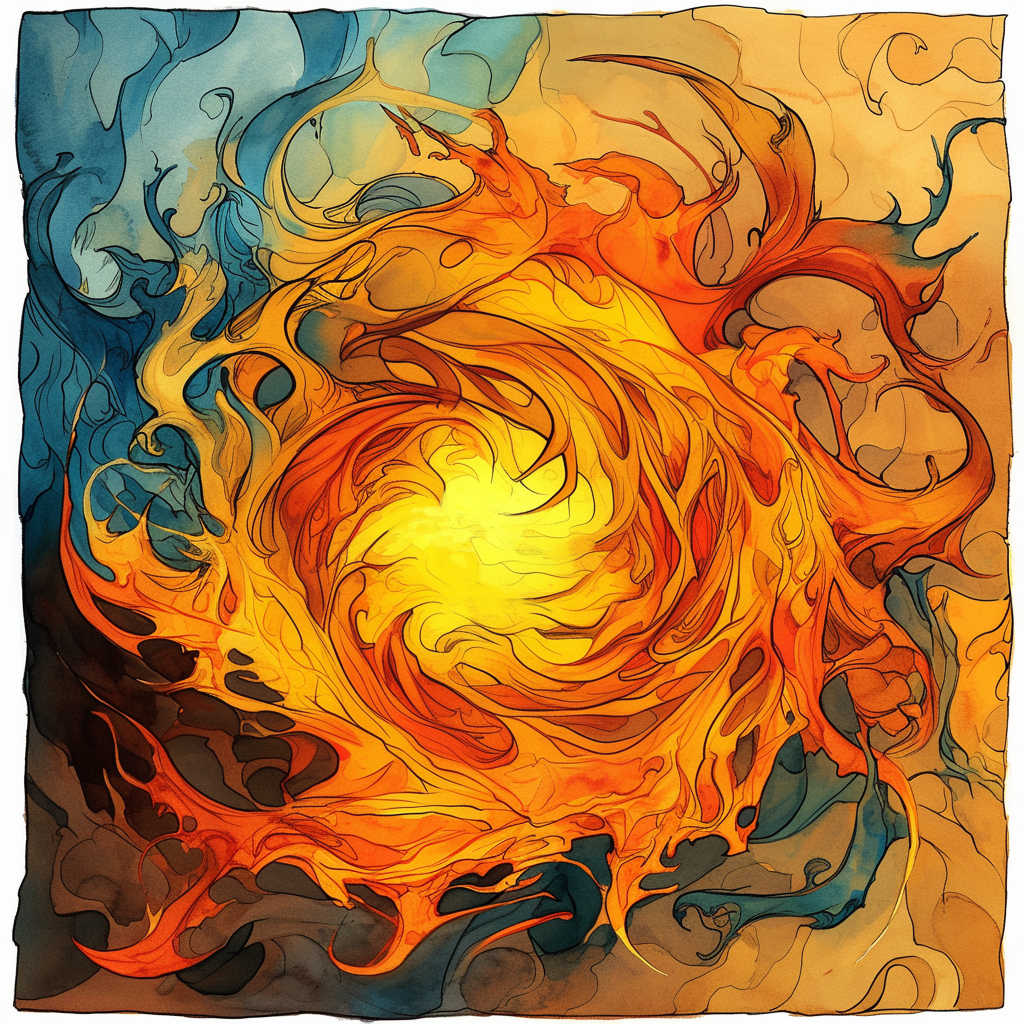
Philosophers, diplomats and negotiators, these rings of intense flame are benevolent and can be approached for aid. Not to be confused with helians. See Elemental, Fire
Stats: [ D&D 2e ] Monstrous Compendium Mystara Appendix [2e]
Mephit, Fire

Also called fire scamps, these small spindly flaming humanoids are notorious pranksters with a cruel sense of humour. Fire mephits are stereotyped as cruel pranksters, though they are more organised than certain berks might expect. They were quite likely created for heating up rooms or cauldrons, and so they have a remarkable connection with the Plane of Fire. Even away from it, fire mephits produce a lot of body heat and can do so for a long time without subsistence. They can feed on almost anything flammable – and on many inflammable things too.
Magma, radiance, ash and steam mephits can also be encountered in the Elemental Fire. More on mephits and the mephit code here.
Stats: [ D&D 2e | 3e | 5e ] [ Pathfinder 1e | 2e ] Inner Planes [2e] p44-45,77; Planescape Monstrous Compendium Vol 1 [2e] p70-71,73-74,77-78; Planescape Monstrous Compendium Vol 3 [2e] p8,10,93; Planescape Campaign Setting [2e] DM’s Guide p31,33; Planewalker’s Handbook [2e] p28; Planar Adventures [PF1] p138; Bestiary 1 [PF1e] p202
Mephling, Fire
A playable race of beings supposedly from the union of mephits an an unnamed mortal race [To be honest I’m not sure I see the point — there is far more interesting lore around the genasi… included here for completeness]
Stats: [ D&D 3e] Planar Handbook [3e] p6,10-12
Omnimental
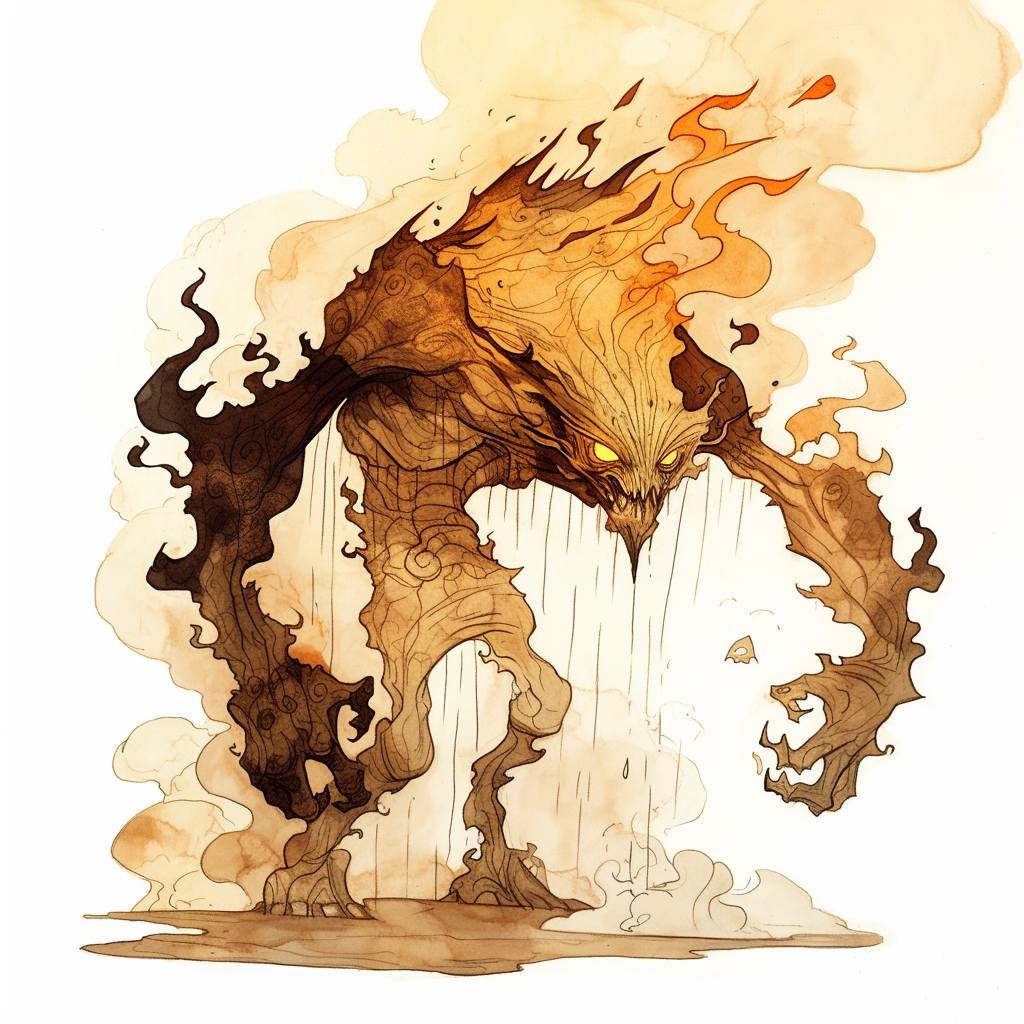
Omnimentals are colossal beings born from the magical fusion of four elemental forces—air, earth, fire, and water. Standing an awe-inspiring 48 feet tall and weighing 10 tons, they are towering manifestations of primal power. Their forms constantly shift between their elemental components, with flames flickering across rocky surfaces, water cascading through their bodies, and swirling winds binding it all together. This amalgamation of elements grants omnimentals incredible versatility, allowing them to traverse and fight in any terrain, including water or nonflammable liquids—something a pure fire elemental could never achieve.
Originally created as intermediaries to mediate conflicts between warring elemental armies in ancient times, omnimentals instead became fearsome warriors who abandoned their diplomatic purpose. Now, they roam the Inner Planes as independent forces of destruction, indifferent to their origins. In combat, omnimentals are devastating opponents capable of attacking multiple foes at once due to their massive reach. When an omnimental is defeated, it undergoes a process the efreeti call Death Birth, where it splits into four huge elementals—one each of air, earth, fire, and water—that continue the battle. Their unique combination of elemental traits makes them nearly unstoppable in battle and untamable by mortal or genie hands. Even the most skilled elemental binders have failed to capture or control them, with disastrous results for those who have tried.
Stats: [ D&D 3e ] Monster Manual III [3e] p118
Onkushu
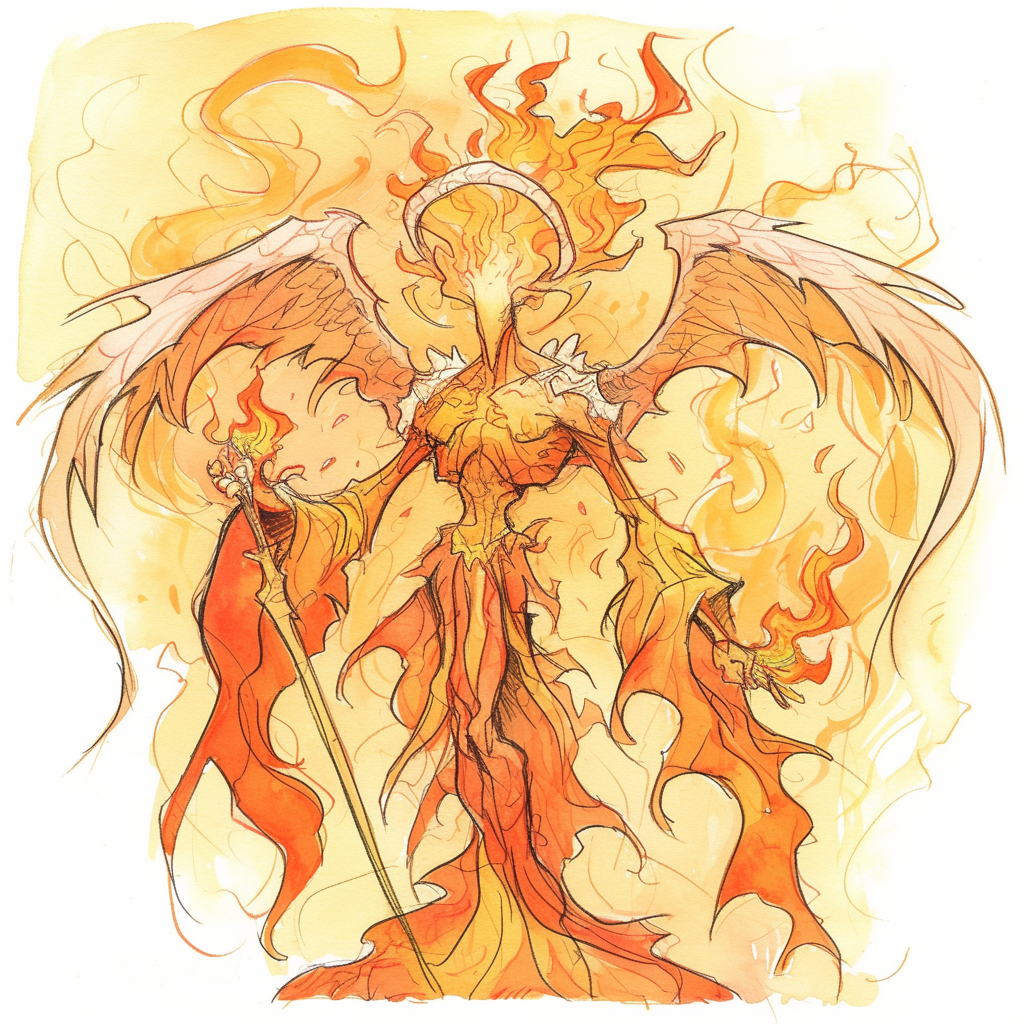
Onkushus are majestic and awe-inspiring beings native to the Deep Fire, their forms a striking blend of alien beauty and fiery power. They possess bodies composed of roiling, ever-shifting flames, with enormous wings of fire that radiate heat and light. Their vaguely humanoid faces are serene yet distant, glowing with an inner warmth that reflects their kind and moral natures. Towering at 15 feet tall and weighing up to 1,000 pounds, onkushus are both physically imposing and spiritually radiant.
For millennia, onkushus have maintained a unique alliance with the aasimon of the Upper Planes, exchanging wisdom, messages, prayers and chant. Through this bond, they’ve learned plenty of celestial lore and practical techniques from the aasimon, while in turn teaching them the virtues of cleansing fire. Though naturally benevolent and inclined toward peace, onkushus are fearsome when provoked, and they are roused to manifest the purifying and destructive aspects of fire. Their presence often inspires awe or terror in those who encounter them unprepared. Respected as both philosophers and warriors of flame, onkushus are rare paragons of morality in the Crematorium.
Stats: [ Pathfinder 1e ] Planes of Power [PF1e] p61 †
Ooze, Bloodfire
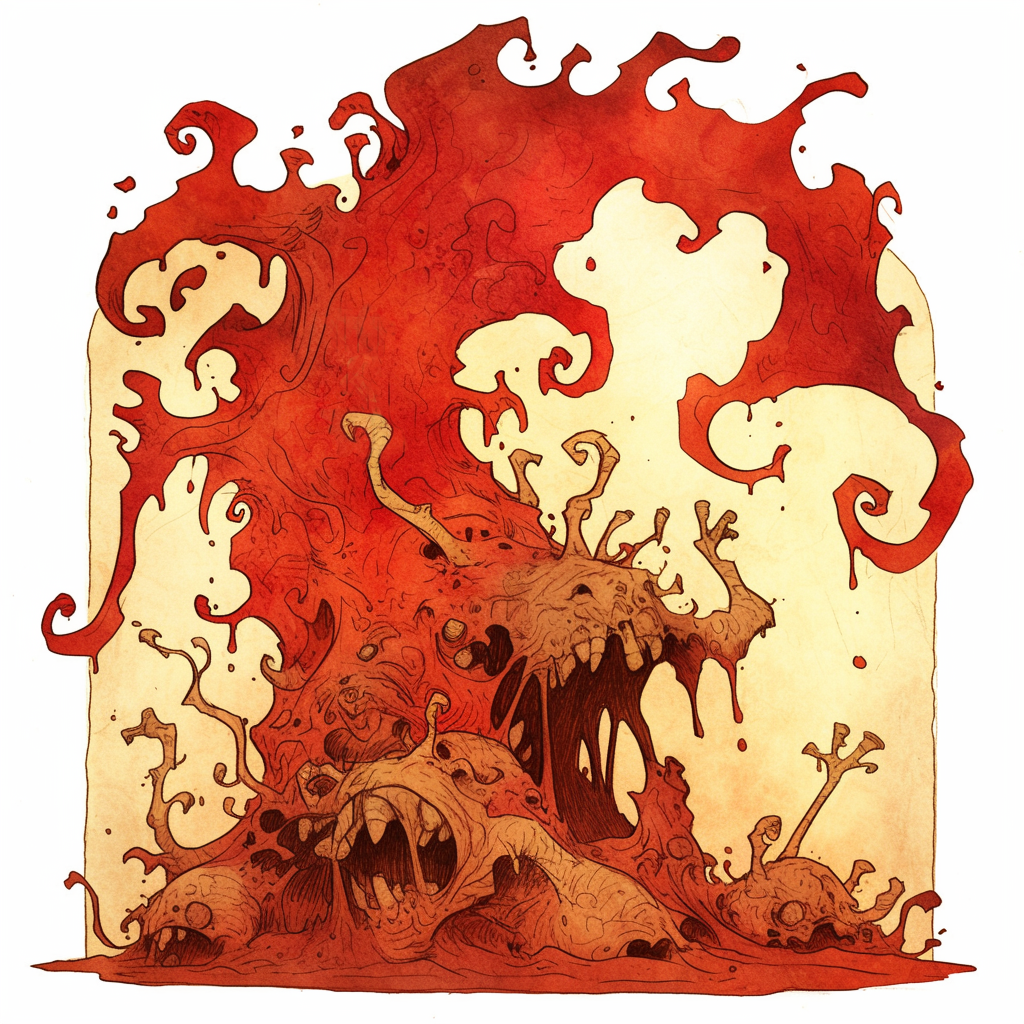
A thoroughly unnatural monstrosity, a bloodfire ooze is an unholy mixture of elemental fire, the blood of innocent humanoids and the ichor of a slain demon. They’re made by the most vile of wizards, tanar’ri and efreeti necromancers and bound to defend , these oozes can be commanded by their creators using simple commands. They are typically used as guardians of horrible places and wicked treasures.
Monster Manual IV [3e] p18-19. See the FR wiki
Phantom Stalker
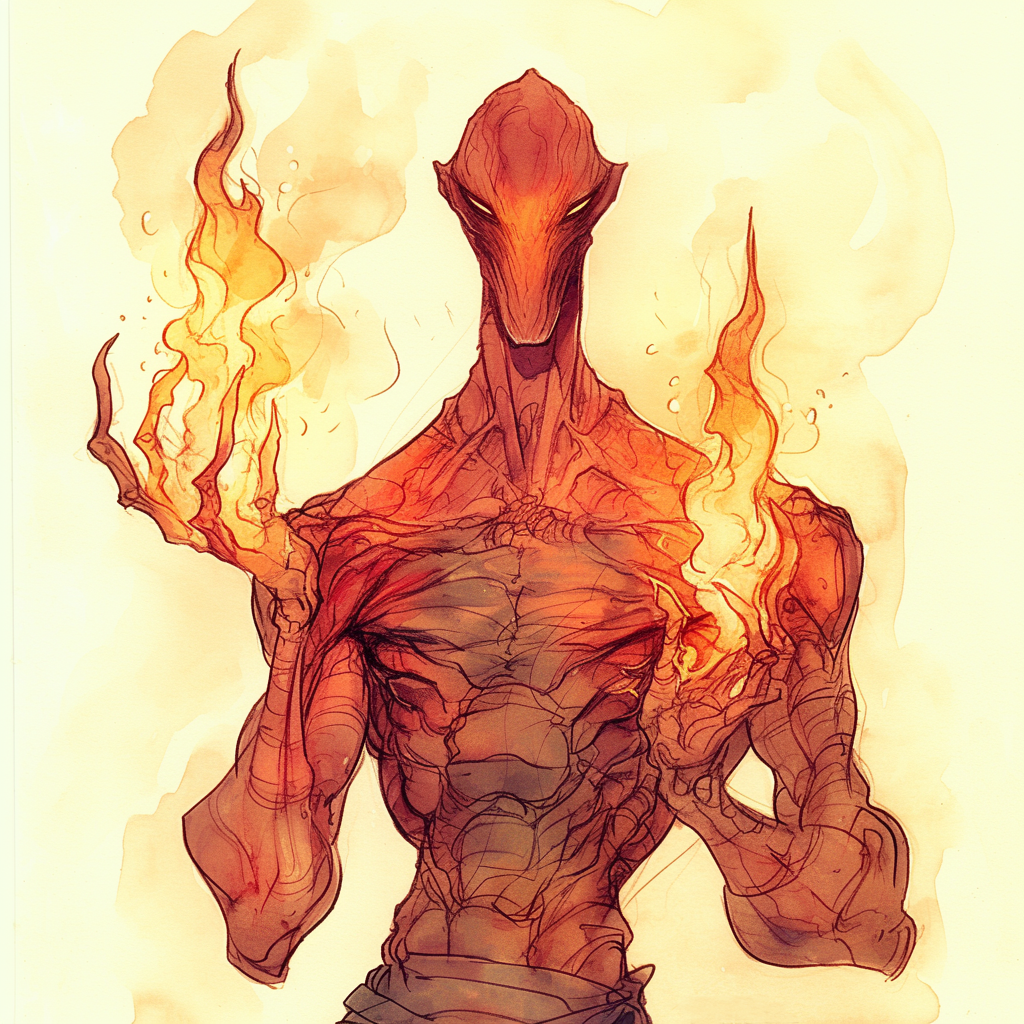
In their natural state these weird creatures are composed of liquid fire. They can harden themselves to appear as a frightening reddish humanoid with enormous eyes. Phantom stalkers are physically more powerful than most fire-dwellers, but they are loners and can be easily subjugated even by salamanders or firenewts. This is why phantom stalkers readily answer calls from casters, who employ them as guards or assistants. Many graybeards scratch their heads at one of stalkers’ ability—when their master dies, they shift to the Ethereal Plane and track the killer down. But why don’t they use this power to escape slavery on their home plane or help their masters while they’re alive? Phantom stalkers seem to not even be aware of their ethereal powers. Just one of the many of mysteries held by the Fire…
Stats: [ D&D 2e | 3e ] Monstrous Compendium Fiend Folio Appendix [2e]
Phoelarchs; Phoera
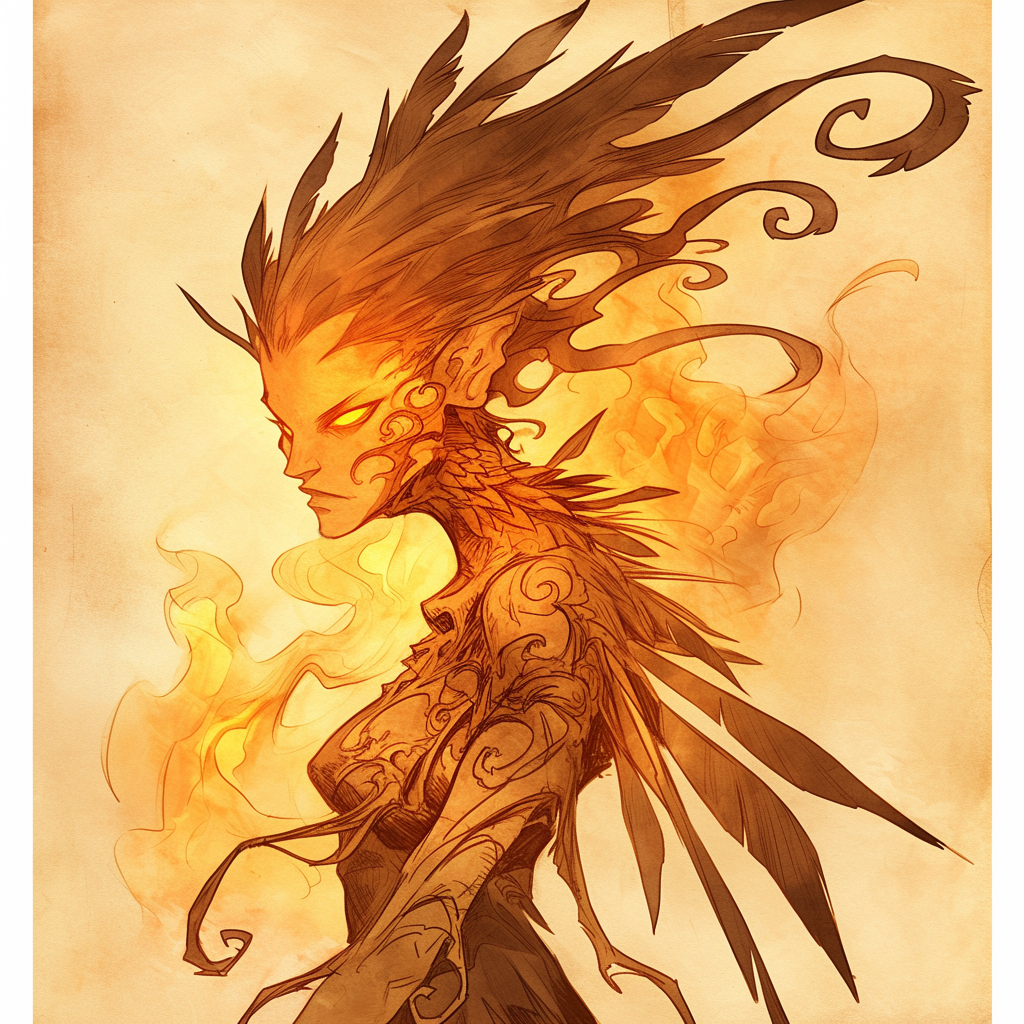
These two very different species are tied together by their heritage—according to legend, they’re descended from mythical phoenixes. Phoelarchs are humanoids with flesh made of metal, fire and healing positive energy. Phoeras are full-on elementals, birds made of gaseous fire and radiance. However, phoelarchs and phoeras are sort of each other’s phylacteries. When a phoelarch dies, while phoera its soul is tied to lives, they leave behind a chrysalis, from which a new phoelarch springs after a 24 hours. And the same happens with phoeras too. However, if one of them is dead (because their chrysalis was destroyed or had gentle repose cast upon it), another one becomes mortal too. For this reason phoelarchs seek phoeras (whom aren’t sapient like them) and tame them.
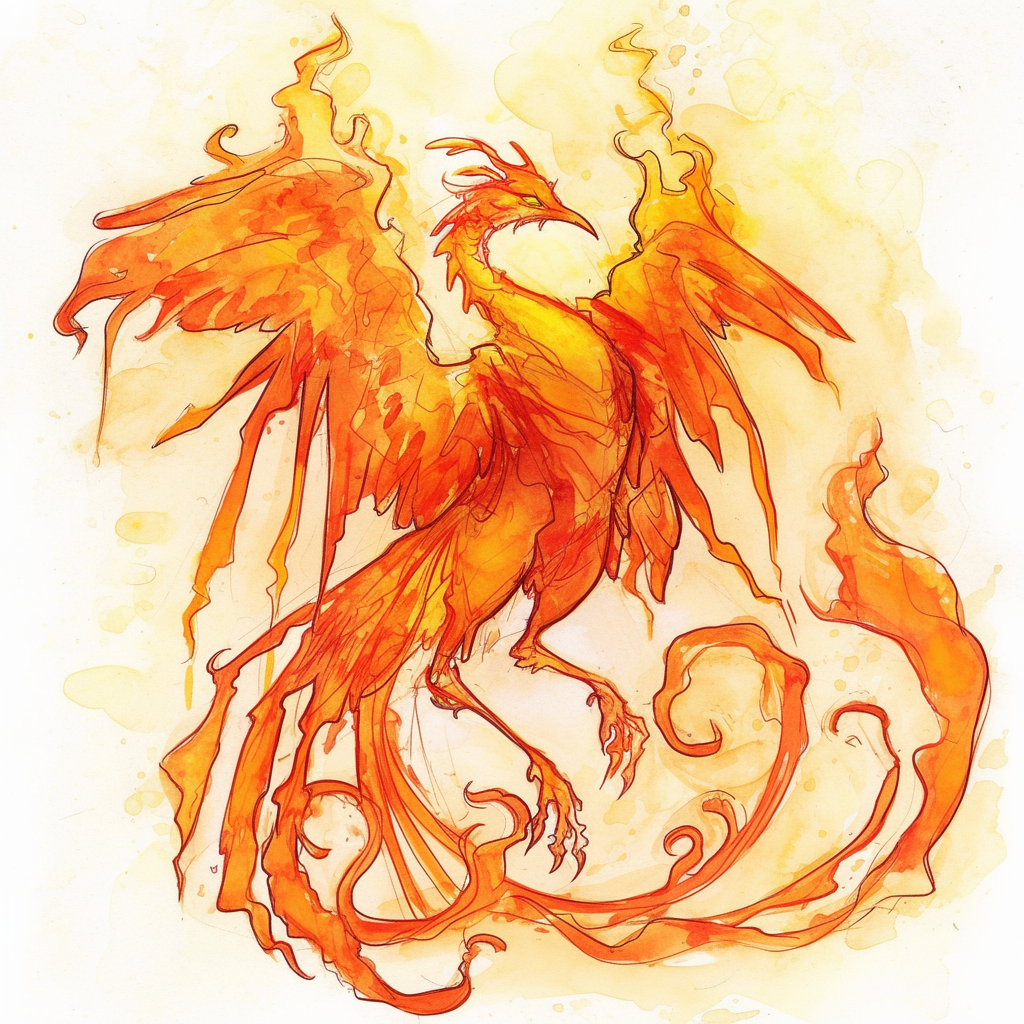
A phoelarch and a phoera who share a soul have the intuitive understanding of each other and together become a powerful force in combat. And combat they do—phoelarchs are firmly on the side of Elemental Good, and they also help weaker races of their plane—ruvoka, tshala and even cinderbrutes. They detest efreeti, salamanders and firenewts for their oppressive ways, even though they’re too outnumbered to take them on directlyy. Phoelarchs and phoeras are strange in many ways, and many sages notice their similarity to an another creature, who is also immortal and has an alternate form being a living fire—the fire bat. Efreeti are quick to claim that the ‘deceitful’ phoelarchs unleashed fire bats upon the plane, but no one can prove this alleged connection.
Stats: [ D&D | 3e ] Monster Manual III [3e] p121; The Plane Below [4e] p65. For some ungodly reason, in canon both phoelarch and phoera turn into phoera upon rebirth, which seems very counterintuitive.
Plasm, Fire
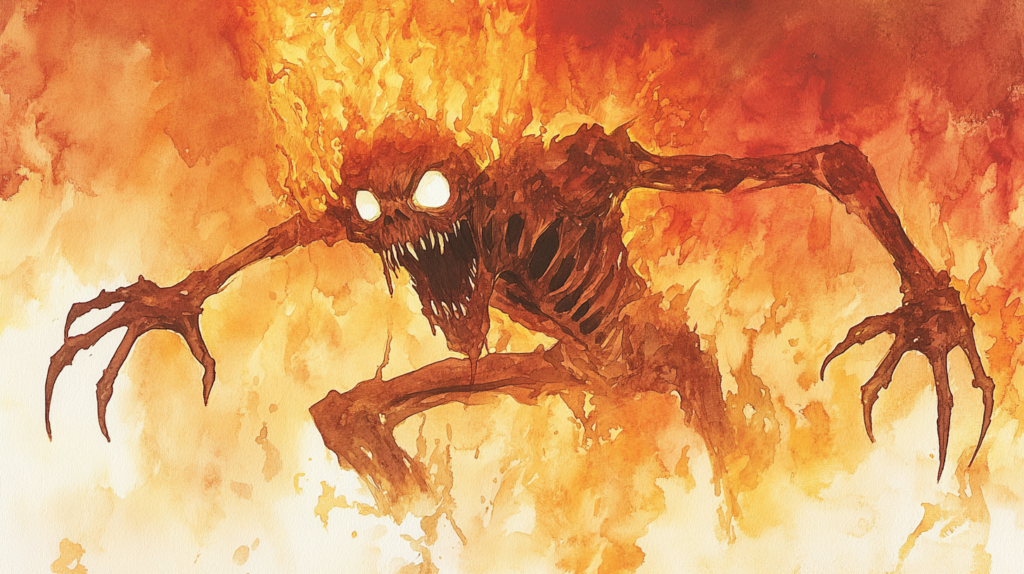
Fire plasms are terrifying creatures that appear as charred skeletons wreathed in ethereal flames that perpetually dance across their scorched bones. They are usually human sized but if you’re really unlucky you’ll encounter a rare giant plasm. They have sinister, glowing yellow eyes, their voices hiss and crackle like burning embers, and they have monstrous clawed hands.On the Elemental Plane of Fire, they regenerate by feeding on fire itself. Be sure not to target them with fire-based attacks, for this will only strengthen them.
In the society of Fire, fire plasms are outcasts and renegades. They refuse allegiance to the Elemental Lords, leading to hostility with normal fire elementals, who attack them on sight. Fire plasms lack any form of structured society or hierarchy; they act independently, cooperating or betraying others based solely on their whims. Their existence is chaotic, born from ethereal storms near the ether curtain borders of the Elemental Plane of Fire, which force elemental fire to fuse with ether, creating these malevolent beings. As such, fire plasms embody pure elemental chaos and serve as agents of destruction wherever they roam.
Stats: [ D&D 2e ] Inner Planes [2e] p44; Monstrous Compendium Mystara Appendix [2e]; Planescape Monstrous Compendium Vol 3 [2e] p8
Pyroead
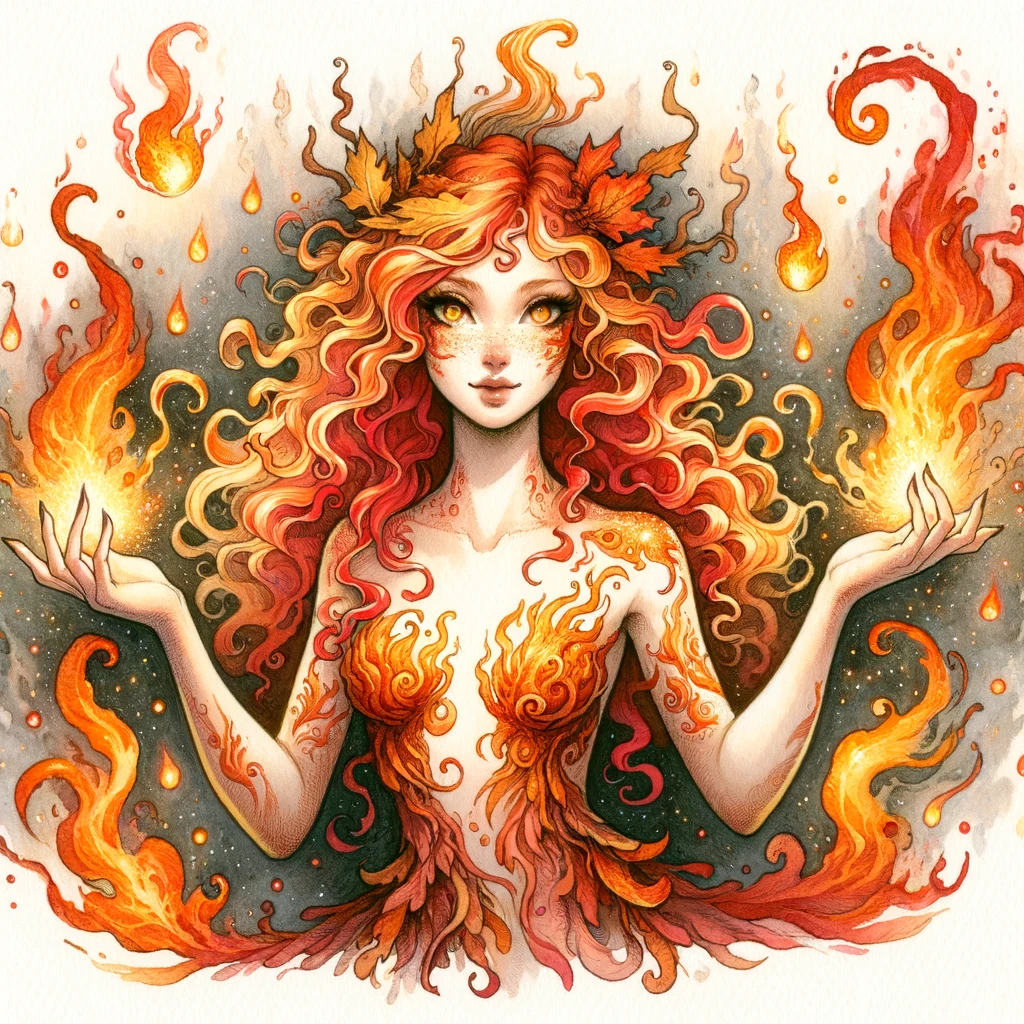
Pyroeads, or fire nymphs are enigmatic beings native to the Crematorium and Muspelheim, embodying the primal and destructive essence of flame. They appear as beautiful humanoid figures composed of roaring fire, with shifting hues of red, orange, and yellow that occasionally flicker into blue or white at their hottest points. Their forms constantly swirl and reshape their features and they radiate intense heat.
In the society of Fire, pyroeads are solitary wanderers or occasional leaders of pyrophors, the chaotic hierarchy of fire elementals. They’re known for their wisdom and fierce independence, and they try to avoid the politics of efreeti-dominated realms. When they do engage with others, pyroeads are often sought after by travellers or spellcasters seeking to harness their knowledge or fiery essence, but they are notoriously difficult to approach without proper protection or offerings.
Stats: [ D&D 2e ] homebrew ‡
Pyrohydra
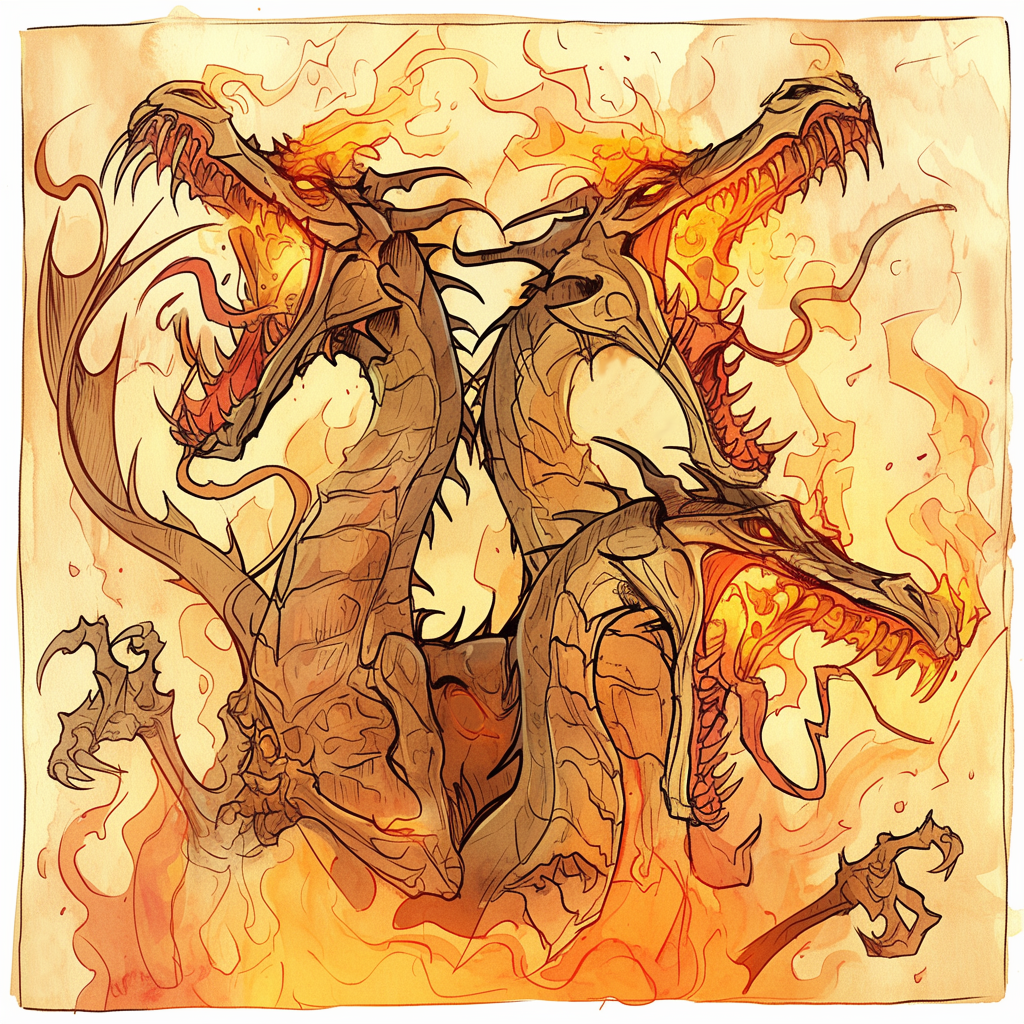
According to some chant-mongers pyrohydras were created by worshipers of Tiamat before they figured out how to make their wretched dracohydras. Like a regular hydra, a pyrohydra is a multi-headed reptilian creature that has unmatched regenerative capabilities. Unlike a regular hydra, however, this magical beast is immune to fire and can even use a breath weapon shaped like a cone of flames. Fortunately, pyrohydras are vulnerable to cold—both cold and acid halt its regeneration. Pyrohydras are rare beasts, which is surprising, considering they have few natural enemies. Guess there’s some secret behind it, huh?
Stats: [ D&D 2e | 3e ] Monstrous Manual [2e]; Monster Manual [3e] p155
Pyrophor
See Elemental, Fire.
Rilmani, Abiorach
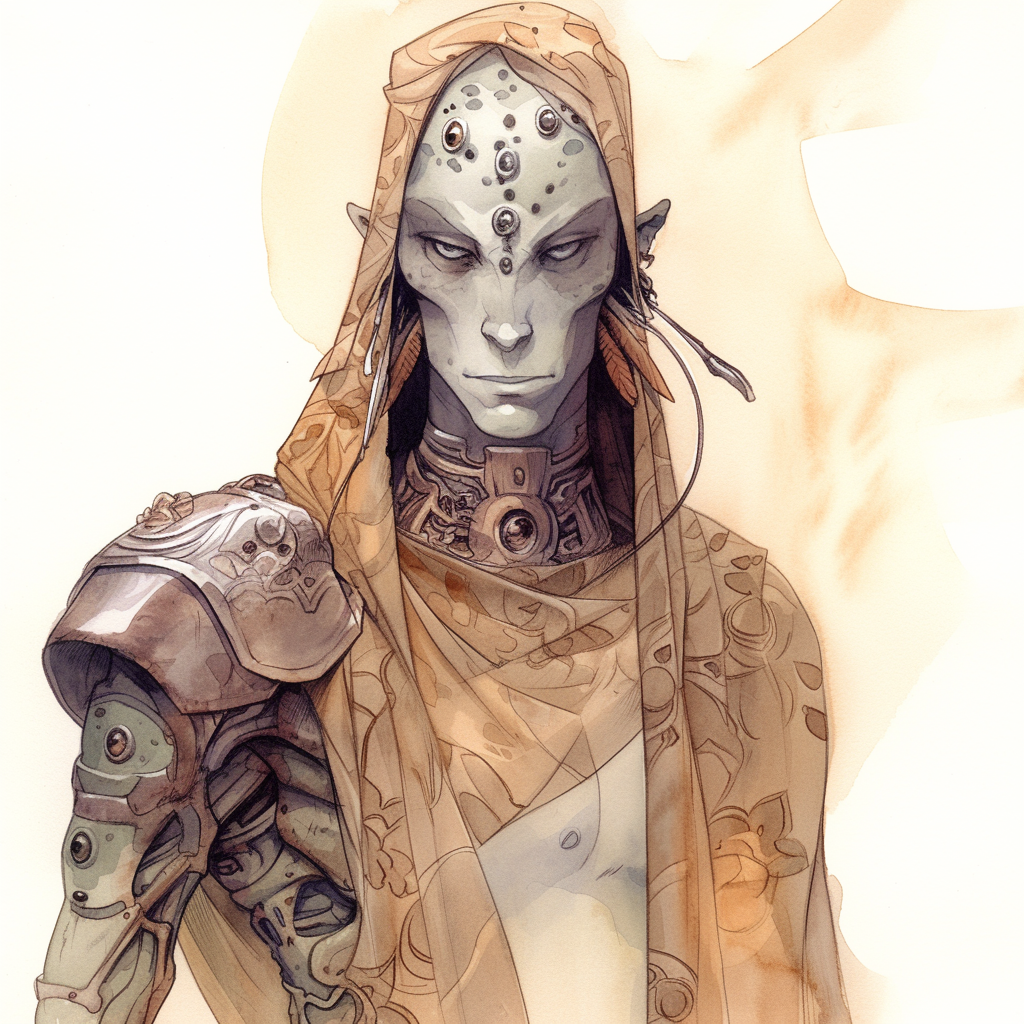
Abiorachs are mercurial rilmani who observe and influence the Elemental Balance. They’re staunchly neutral beings who monitor the Inner Planes for inscrutable reasons. These cutters play the game with the gusto of a water genasi running through a bonfire. They’re beings who appear as youthful and sprightly as a pack of tiefling urchins, but with the sheen of liquid quick silver for skin, shimmering and shifting with every pirouette and leap. Their eyes are jewels that capture the light of the multiverse, sparkling with the mischief and wonder of a child who’s found a portal to the playground of the gods. More chant on abiorach here.
Stats: [ D&D 2e | 5e ]. Planescape Monstrous Compendium Vol 2 [2e]; Manual of the Planes [5e] p317
Ruvoka, Kaltori
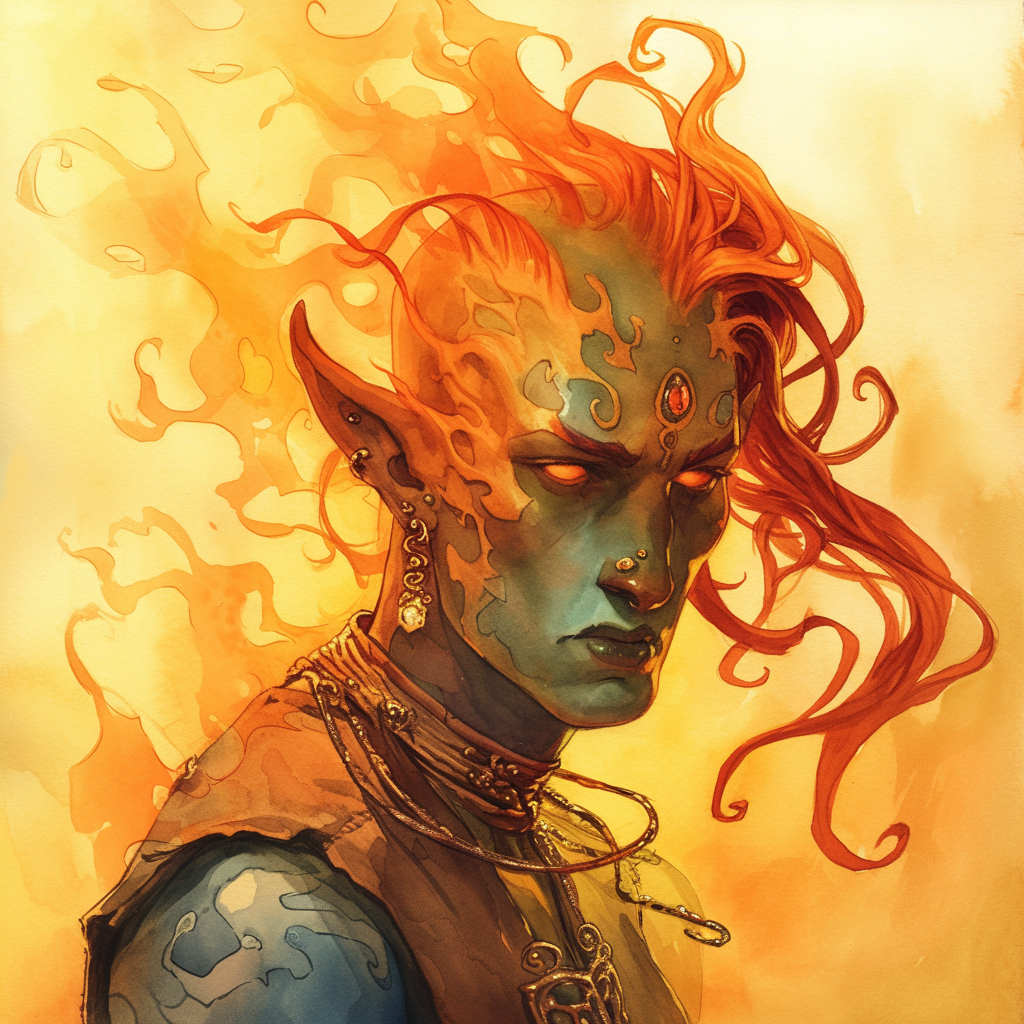
The Kaltori tribe is the most well-known tribe of ruvoka in the Elemental Fire. They are, like any other ruvoka, mysterious humanoids, who protect certain important places and beings. Kaltori ruvoka build their homes around red gum trees which they spread and cultivate, while their nomadic communities travel with the fire whales. Some say that the Kaltori tribe used to be two different tribes—one worshiped whales, another—trees, but they had to merge to better combat efreeti and salamanders, who, as always, wished to claim those treasures for themselves. Other tribes of fire ruvoka are rumoured to exist in the Deep Fire, where they guard the mysterious and powerful phenomena found only there.
Stats: [ D&D 2e ] Planescape Monstrous Compendium Vol. 3 [2e] p90-91
Salamander
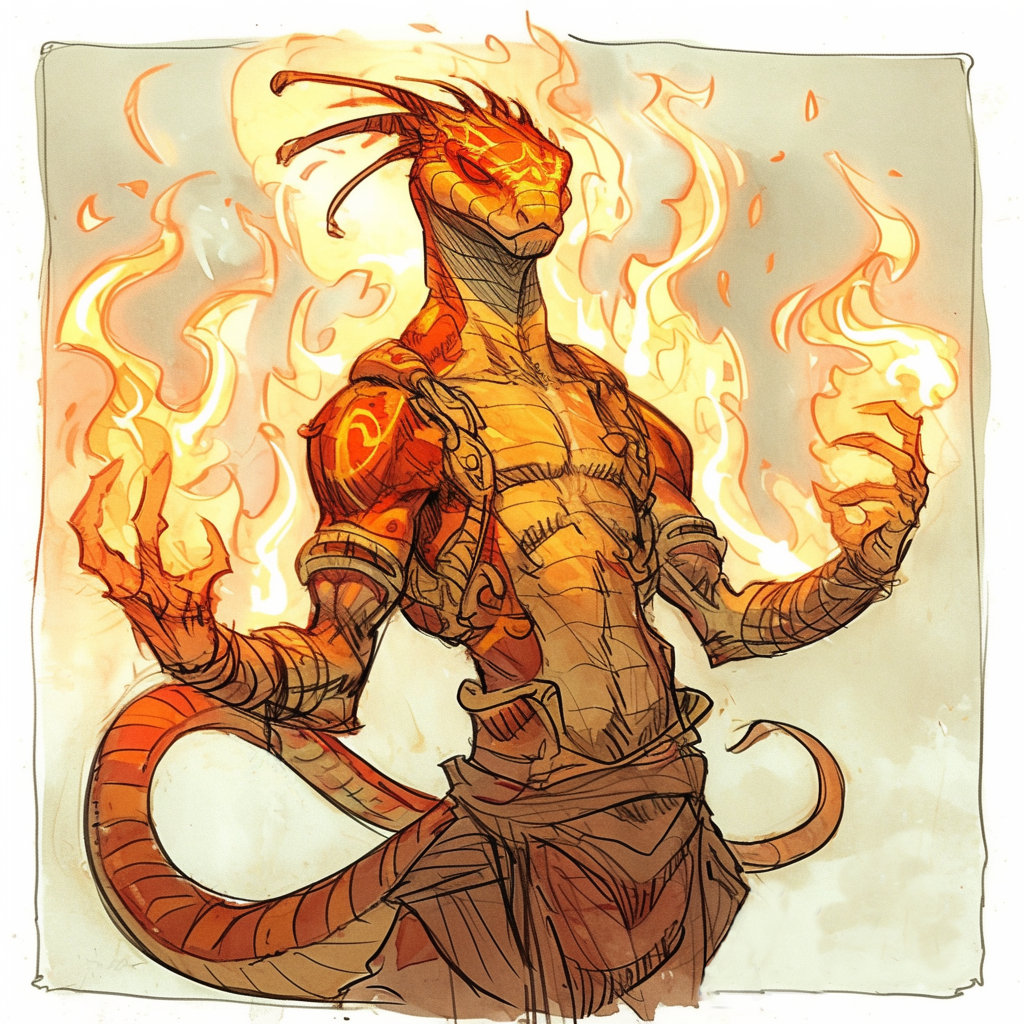
If the efreetibuilt the greatest empire in the Crematorium, then salamanders built the second greatest. They look like snakes below waist and humanoids above waist, though their heads are more rooster-like. Salamanders reproduce asexually, laying eggs that hatch into larvae called fire snakes (not to be confused with flame snakes). Fire snakes are neotenic—they can mature into salamanders, but can also remain fire snakes, if the conditions are right (or if they possess some sort of a genetic defect). Most of them are kept and guarded by salamanders, but some escape and live in the wild, where they can even breed, without ever becoming salamanders. Fire snakes have powerful jaws and paralytic venom, so salamanders keep them as guard dogs until (or if) they can grow up. After approximately ten years fire snakes mature into adult salamanders through a short sub-adult stage known as flamebrothers. Salamanders grow in power with age, and those of them, who lived to 600 years, become salamander nobles, who occupy the highest positions of power in their society. Salamander kingdoms are extremely gerontocratic and xenophobic: even among efreet a non-efreet can reach social heights, but in a salamander kingdom non-salamanders are nothing more than peasants. Salamanders also have a troubling tendency to worship tanar’ri lords.
Stats: [ D&D 2e | 3e | 5e ] [ Pathfinder 1e | 2e ] Bestiary 1 [PF1e] p240; Planescape Monstrous Compendium Vol 3 [2e] p92; Inner Planes [2e] p43; Planescape Campaign Setting [2e] DM’s Guide p31; Planewalker’s Handbook [2e] p28
Scape
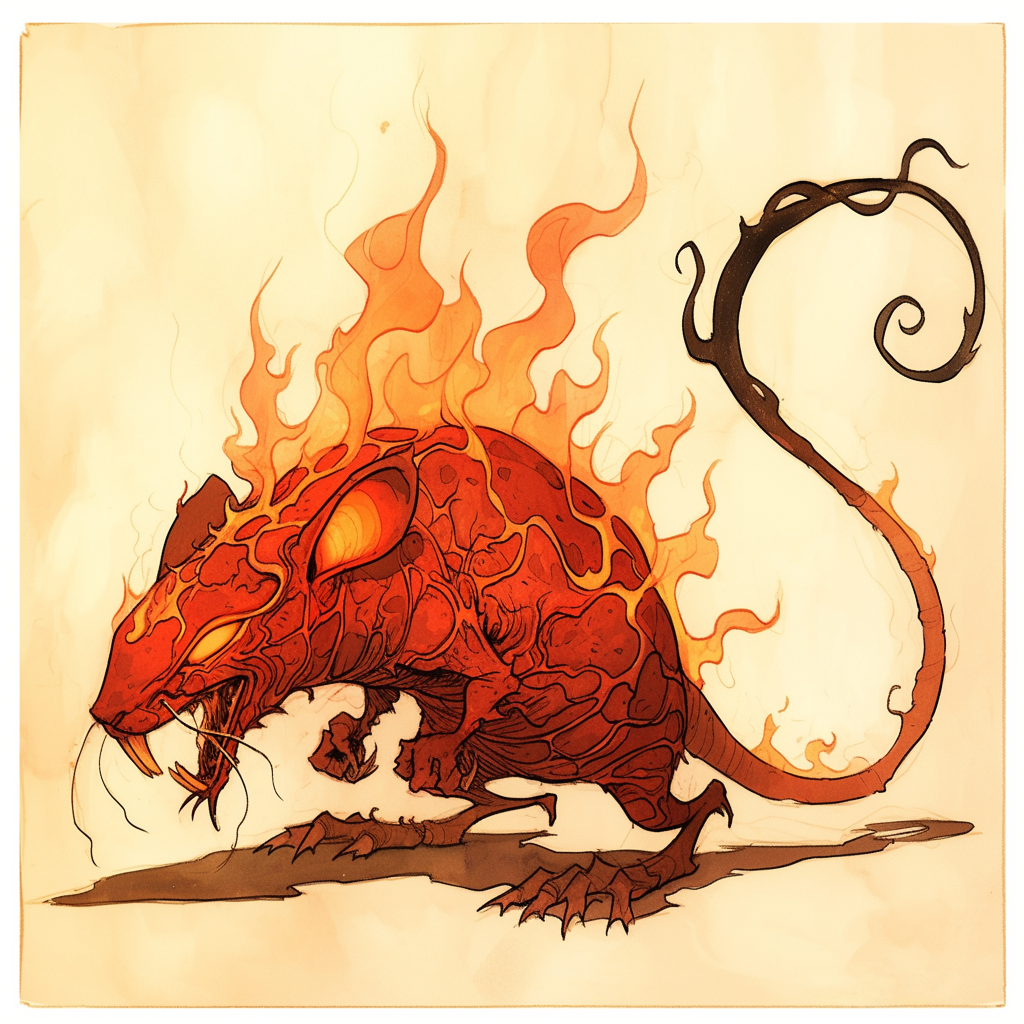
Scapes are surprisingly intelligent hairless rodents, notable for their ability to teleport. They are highly resistant to all manner of poisonous substances, which makes them able to feed on ember roots and on all kinds of bugs and plants. Their favourite meal, however, is carrion. They have to reach it quickly, since carcasses quickly decay in the flames. That’s where their innate magic comes in play—scapes can teleport long distances. This ability, together with thick hide that protects them from temperature drops and increases, has made them truly widespread—they are found even in the City of Brass, which is normally too frigid for other fire pests. However, this ability comes at a cost—scapes must constantly eat to maintain their high metabolic rate.
Stats: [ D&D 2e ] Inner Planes [2e] p44; Planescape Monstrous Compendium Vol 3 [2e] p122. No stats, just a mention.
Snake, Flame
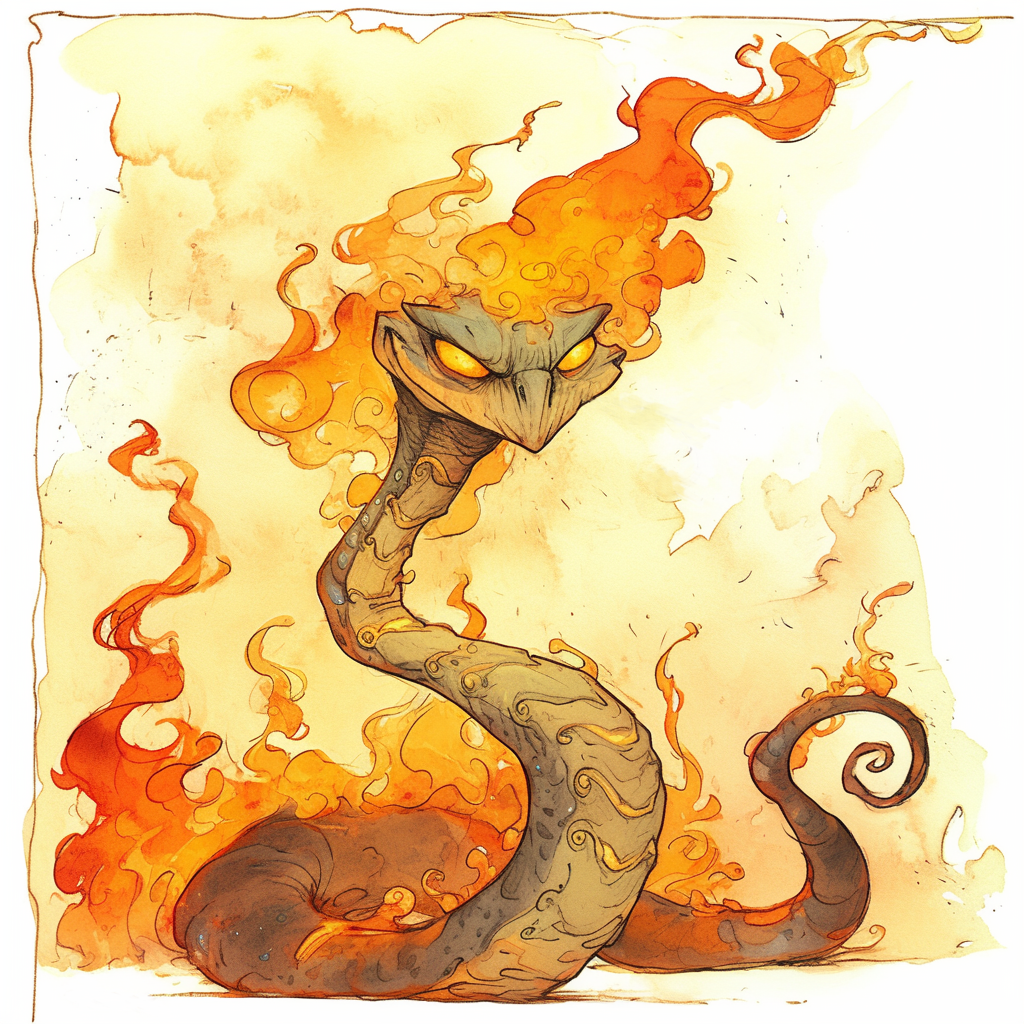
Flame snakes are in fact an assortment of multiple species of related creatures—the molten adder (minor flame snake), common spiketail (lesser flame snake) and royal igniter (greater flame snake). All of them hunt small prey, using both potent venom and constricting coils. Lesser and greater flame snakes can also spit their venom. Their venom is based on pure elemental fire and burns blood vessels it flows through. It is deadly for non-fire creatures, but relatively mild for flame snakes’ prey. Common spiketails also have a single spine on the tip of the tail. They use this to dig solid fire where they lay their eggs, but also as a part of courtship rituals. They are intelligent enough to be trained as used a brutish watchdogs. Royal igniters are actually sapient and can cast a number of innate spells. One legend says that they used to be noble baatezu, cursed for their transgressions, but more talkative royal igniters dismiss it as a myth. Not to be confused with fire snakes.
Stats: [ D&D 2e | 3e ] Inner Planes [2e] p45; Monstrous Compendium Annual 1994; Fiend Folio [3e] p73-75
Striders

Striders are flightless, featherless birds, covered in red or black scales. They are omnivores, who prefer plants as food. There are multiple species of strider—dwarf, golden-beaked, ashen, fluorous and giant. Most of these striders are wild and often hunted by other creatures, but giant striders were domesticated by firenewts. All striders can run across the liquid fire—their legs are so powerful and move so fast, they momentarily make liquid fire solid under their feet. Dwarf striders are small and have hides coloured red and orange as camouflage. Golden-beaked and ashen striders are the most common kind, and are distinguished only by their colour and habitat. Fluorous striders are a notable species—they live in places contaminated with fluorite, a substance that is deadly even for most creatures of Fire. Their skins are pale-yellow and acid-resistant, and their meat is virulently poisonous.
Stats: [ D&D 2e ] Monstrous Compendium Annual 1996
Suli
A term for beings who are planetouched by geniekin, specifically by the jann.
Stats: [ Pathfinder 1e | 2e ] Bestiary 3 [PF1e]; Ancestry Guide [PF2e] p108. In PF2 game terms, suli is a versatile heritage for PCs who have genie ancestry; like the genasi. †
Swallow, Flame
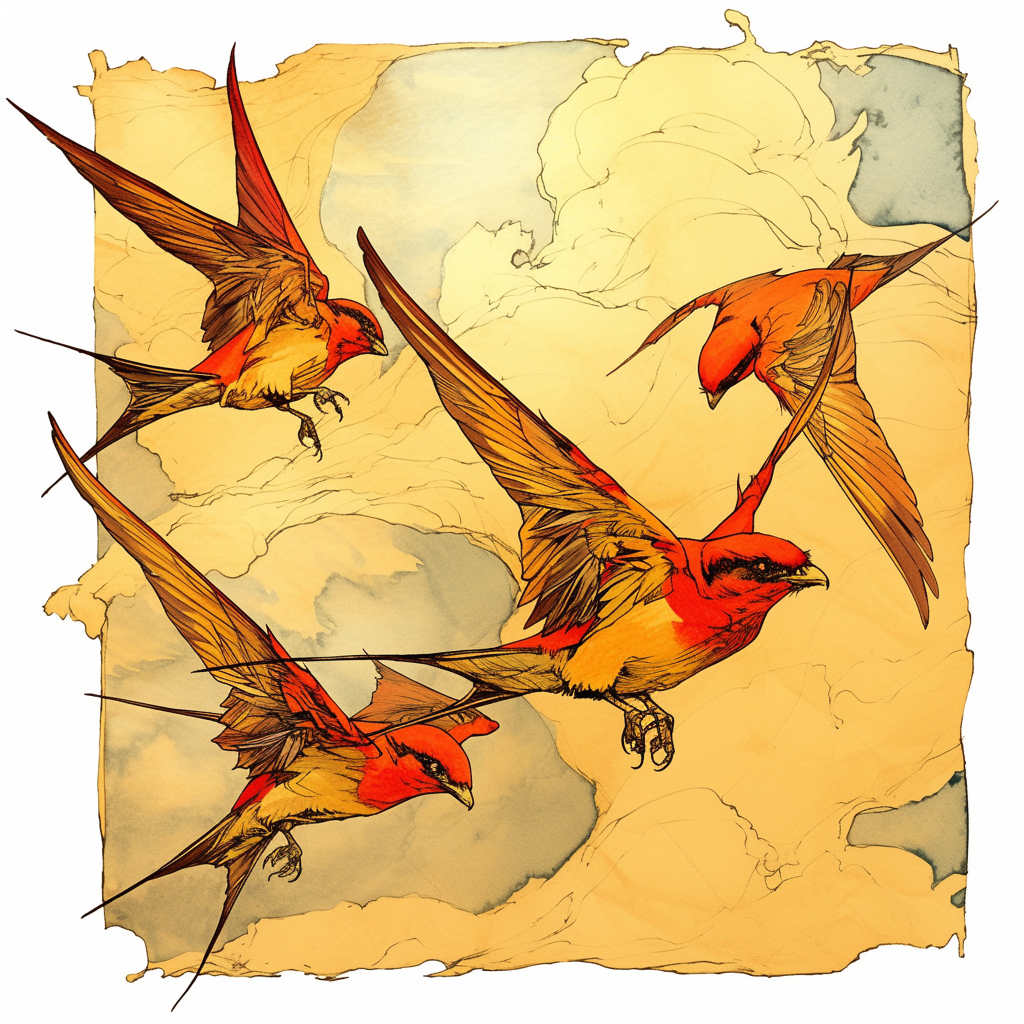
Flame swallows are magnificent, graceful birds similar in appearance to terrestrial swallows, except that their wingspan is often five feet or more. They have the same forked tail as swallows. Their colour is bright red on the back of the head and down the back, shading to brilliant orange on the upper surfaces of the wings and on the tail. Their bellies and the undersides of their wings are bright yellow. Their beaks are short, but sharply-pointed, and can deliver a nasty bite.
Flame swallows soar through the plane by creating jets of propulsive flame. There are many different species of them, distinguished by their coloration and place of nesting. Some dig nests in the Burning Ridges, others build them in the canopy of red gum trees, and many diving species make burrows at the bottom of the fire ocean. Many of them find their way onto the Prime fire worlds (stars and certain planets). In fact, these worlds are much better suited for their survival, since their atmosphere is dense enough to fly without spending energy on propulsion. However, stars rarely have suitable places for building a nest, so such swallows have to migrate through vortices between two planes. Flame swallows can sustain themselves on elemental fire for some time, but they generally feed on small flying fire insects and plankton they can dive for. However, they have powerful beaks, and some flame swallows were observed attacking and eating fire bats.
Source: Practical Planetology [2e]
Tome Guardian
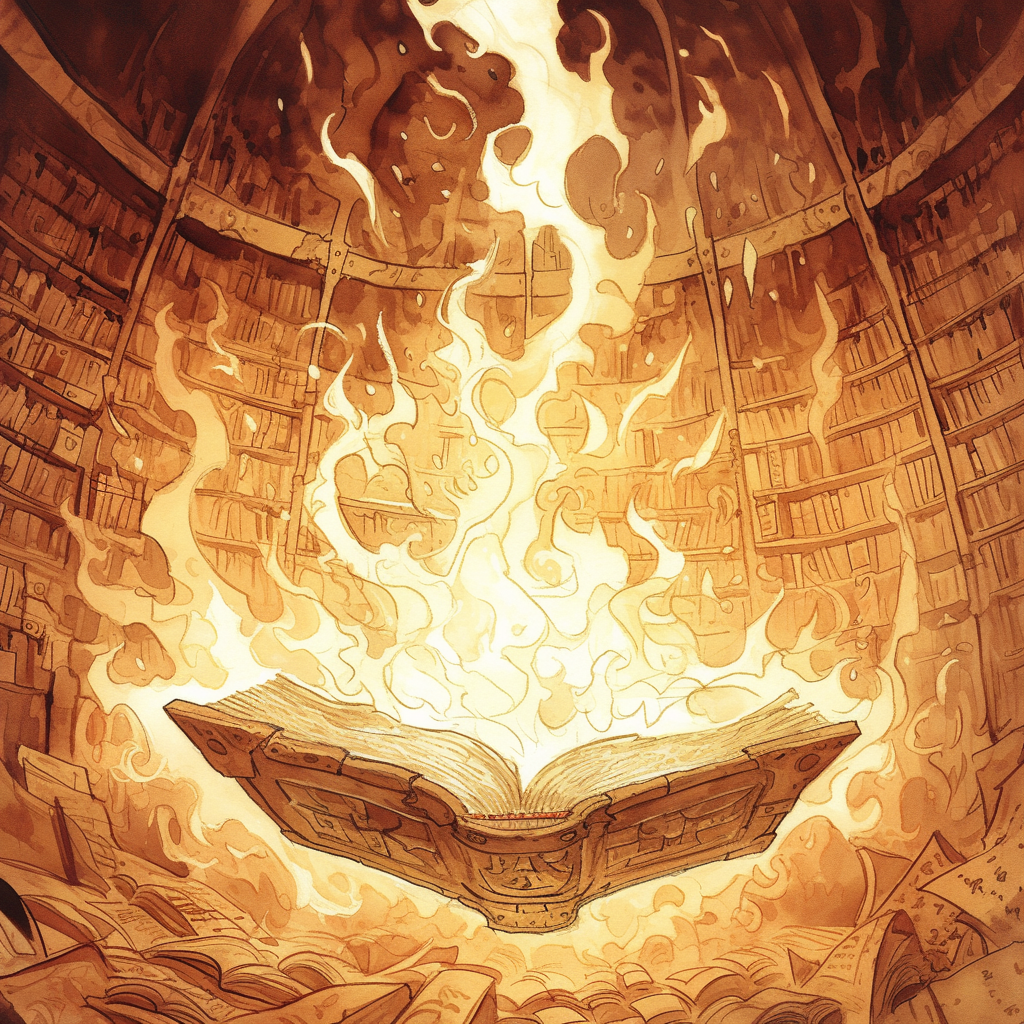
Usually encountered on the Prime as a summoned elemental bound to a valuable book, in their native habitat tome guardians are treasure collectors like magpies. Now these are mysterious creatures. They are able to spread their bodies so thin, that they become all but invisible, detectable only by their heat (or truesight). In their native environment tome guardians are never attacked by other creatures—not only they are insignificant and hard to find, but they also have a powerful defence mechanism called fireburst or flame stinger. Threatened tome guardians can emit a thin stream of white-hot flame that is so powerful that it can hurt even fire elementals. There are reports from divination mages, who claim to have been attacked by the tome guardian through their own scrying spells, which suggests that those creatures have some sort of unknown magical abilities in them.
Tome guardians are able to absorb not only flames (something which many creatures on this plane can do), but also lightning and positive energy-based attacks. This suggests that these creatures perhaps have some ties to the Positive Energy Plane and further muddies the metaphorical waters, when it comes to tome guardians’ origins. Regardless, in Fire tome guardians attach themselves to small and solid items. They especially value items that hold information (like books)—tome guardians do seem to prefer something that can keep them entertained. Several adventuring mages have recounted finding ancient books, that have been long decayed to the point of being unreadable—but then tome guardians who had guarded these manuscripts for centuries were able to perfectly recount the contents that they’d memorised perfectly. This willingness to guard things and love for knowledge means tome guardians are appreciated by both genies and mortal mages.
Stats: [ D&D 2e ] Monstrous Compendium 1996 Annual [2e]
Veela, Fire
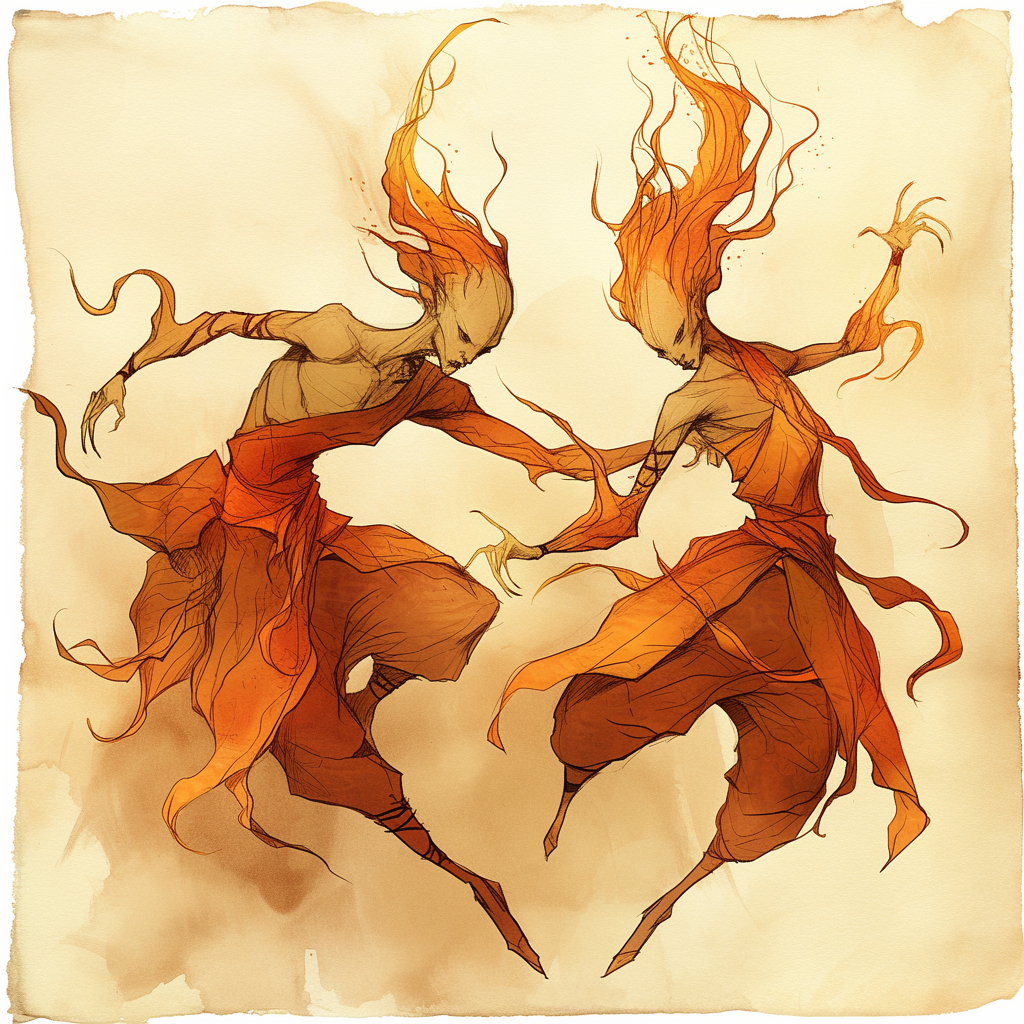
Fire veelas are breathtakingly beautiful humanoids, and they exude an aura of elegance and raw elemental power. They have lithe androgynous bodies with flawless, fiery-hued skin that shimmers like molten metal or the embers of a dying fire. Their hair flows like living flames, constantly flickering and shifting in intensity. Their eyes burn like glowing coals, and their expressions often carry an air of mischief or playful allure. Their movements are fluid and hypnotic, as if they are always engaged in an intricate dance. Fire veelas typically wear flowing garments woven from smoke and flame, and their bodies are wreathed in a luminescent halo of fiery energy, which they can intensify to act as a shield.
In Core Fire, fire veelas often form small troupes to revel in the unrestrained energy of their environment. They are known for their signature beckoning dance, a magical performance that compels others to join them. Cutters caught in this dance must match the veela’s skill or risk fatigue or even damage and fatigue. However, those who succeed in out-dancing a veela will earn its respect and even benefit from its healing magic. Fire veelas rarely use their dance as a weapon unless provoked or in dire need, preferring instead to engage willing partners who leave exhilarated but drained. Despite their capricious nature, fire veelas are not inherently malevolent; they are playful spirits who cherish freedom and the joy of movement.
Stats: [ Pathfinder 1e ] Bestiary 5 [PF1e] p264
Waiveras
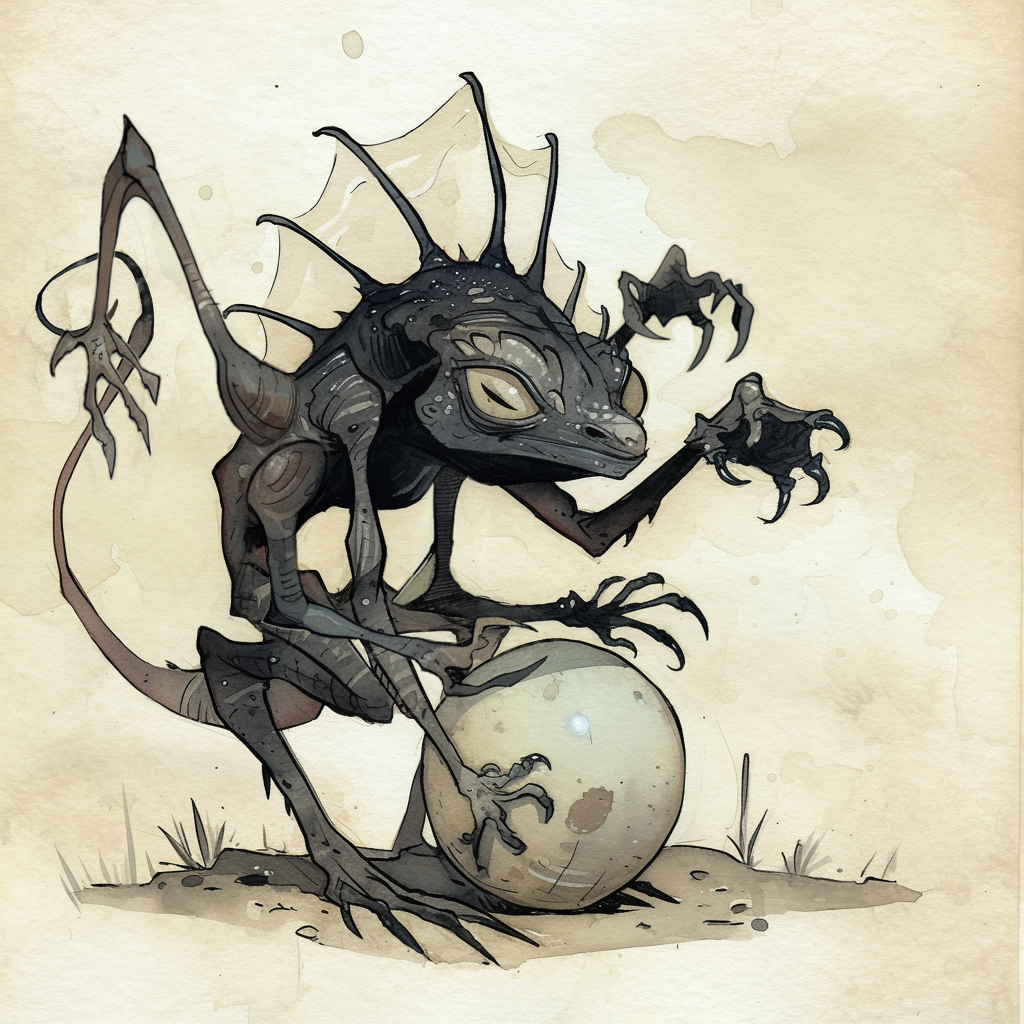
Waiveras is a black lizard with eight legs. They hunt insects and fish and can breathe liquid fire just fine. They especially crave eggs, which makes them dangerous pests for salamanders. At the same time, salamanders, firenewts and many other natives hunt and eat waiveras. These creatures are very numerous on the Plane of Fire.
Stats: [ D&D 2e ] Inner Planes [2e] p44; Planescape Monstrous Compendium Vol 3 [2e] p 122. No stats, just a brief mention.
Weirds
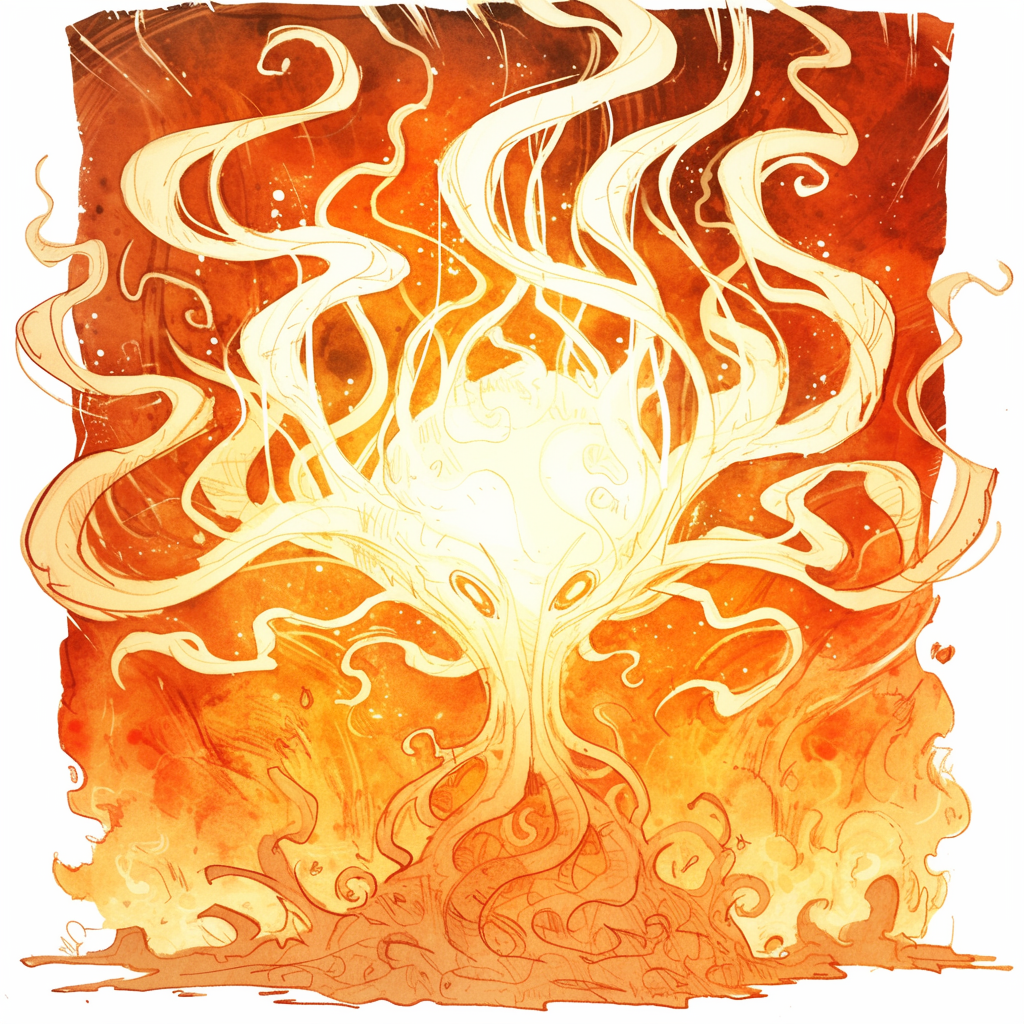
Fire weirds, like all weirds, see themselves as protectors of their plane. Physically, they appear very similar to regular elementals, but have additional abilities. Like other elemental species, fire weirds tend to fight by enveloping their opponents and battering them from all directions. Fire wierds, however, have another trick up their sleeve. When a situation is dire enough, a fire weird can destroy itself, erupting in a net of sticky goo of liquid fire—even creatures that are immune to fire are at least restrained by this attack.
Fire weirds aren’t afraid to die, so even inhabitants of the Plane of Fire are hesitant to mess with them. However, forces of Olhydra and Gazra are still threatening the plane, so eventually the weirds will have to fight. One would think that such creatures would ally with Imix, but so far, they have not. The Prince of Evil Fire Elementals wants to engulf all of the existence in flames, and the weirds, whose entire purpose is to maintain the Crematorium as it is, are opposed to this. Chant goes they actually have a loose alliance with Zaaman Ruul. Curiously, this situation has deeply affected the greater weirds—now their predictions are about hope and love, as they try to be more empathetic and generally good to balance out the wickedness of Imix’s minions. However, it is hard for weirds to connect with fleshy beings, who exist in such different conditions, so frequently their cryptic words do not come across as anything particularly hopeful.
Stats: [ D&D 3e | 5e ] [ Pathfinder 1e ] Dragon Magazine #347 p66,69-71 (the ecology of the weird); Monster Manual II [3e] p91,93 (93). Canonwatch: Several sources state that weirds are found in all of the elemental planes, but stats are given for only a subset. I rebranded Weirds from 3e as “greater weirds”. Maybe it is more canonical to make regular weirds “lesser”, but I think that in more recent editions weirds are more associated with mimicking elementals in a pool than with prophetic ladies.
Whale, Fire
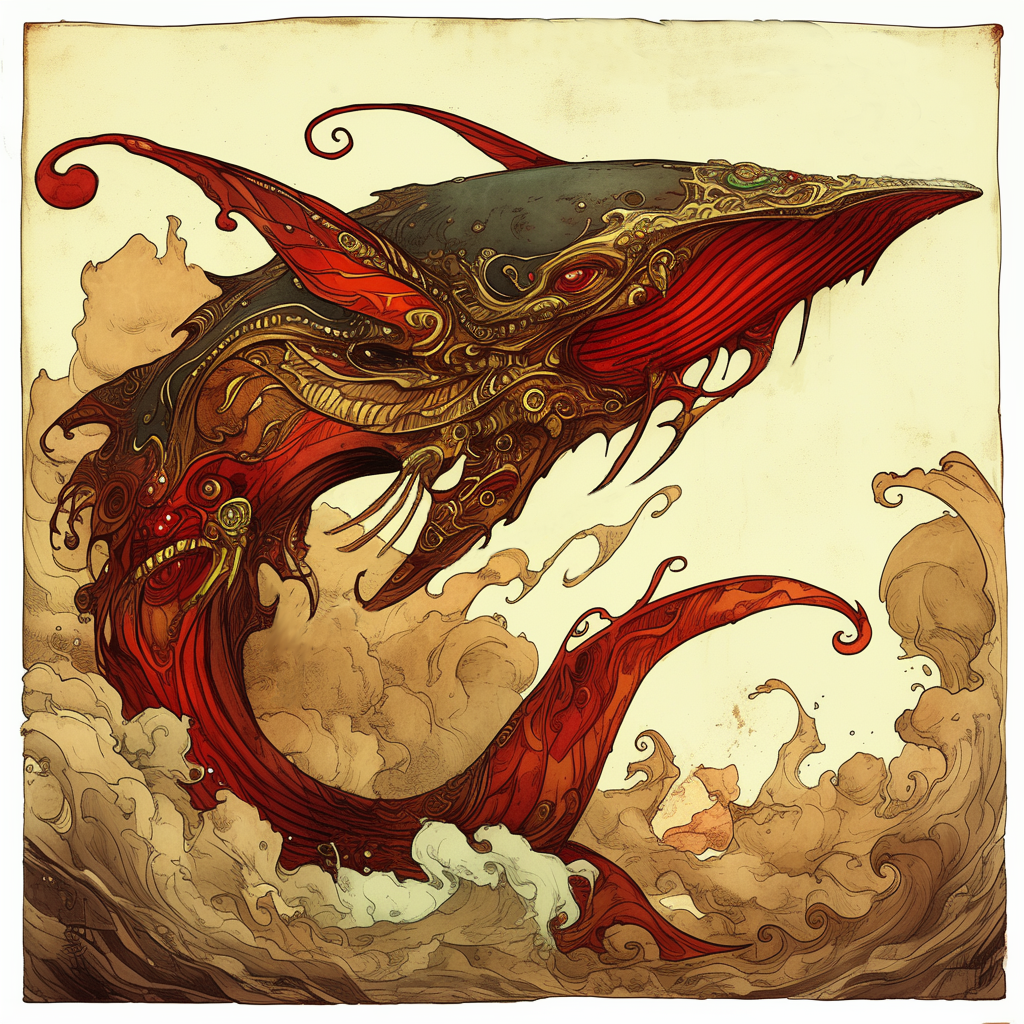
These titanic majestic creatures travel far and wide through the Crematorium, and are often found in the Plane of Magma too. Most fire whales are small as far as whales go, since the fiery ocean is very shallow compared to actual seas. However, there are giant species, especially in the Everlasting Firestorm, where the liquid fire strata is deeper. Fire whales generally feed on plankton, but there are orca-like species, who feed on other whales. Fire whales also consume materials like molten rock and metal. Some of these materials then get deposited in the whale’s hide, sometimes as appealing gemstones. For these stones (and also for meat and fat) fire whales are hunted by many unscrupulous natives and adventurers (something, which greatly displeases the kaltori ruvoka). Interestingly, fire whales are immune to water and can even exist in bodies of water, surrounding themselves with the layer of steam. The ecological consequences of such creatures existing in these circumstances are unknown.
Stats: [ D&D 5e ] [ Pathfinder 1e ] Bestiary 6 [PF1e] †
Wisp, Fire
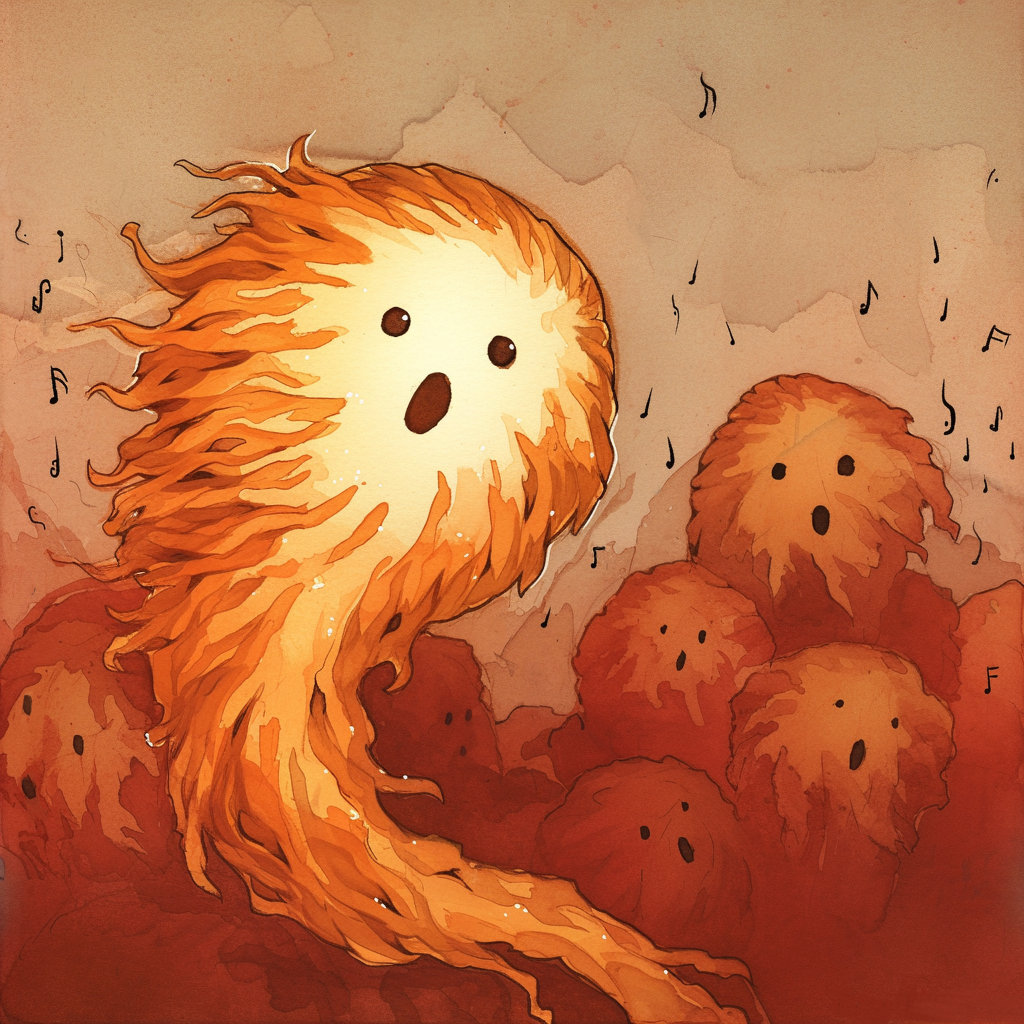
Fire wisps are tiny, sizzling spheres of flame and ash, perpetually crackling and shimmering with heat. They resemble jets of fire, ranging between six inches and one foot in height, often glowing in vibrant hues of green or blue. Their gaseous forms flicker continuously. Despite their diminutive size, fire wisps radiate elemental energy and have strong carefree, boisterous personalities. They are quick to action, often impulsively leaping into situations with enthusiasm.
Fire wysps trace their origins to the creation of the Elemental Planes, when the first wisps roamed the Inner Sphere in vast symphonies. These symphonies created hauntingly beautiful music from their combined resonances, a sound so powerful that it drew the attention of the Elemental Lords. Seeing the potential of these beings, the Lords enslaved entire symphonies for use as servants. Today, most fire wisps live in servitude to these masters, but free wisps still roam the Inner Planes and even the Material Plane. These free spirits are shy around strangers but will eagerly offer their services to those who show them kindness. They are especially drawn to spellcasters who practice elemental magic, often becoming loyal familiars or companions. Particularly devotes wisps may even sacrifice themselves to protect their companions.
When fire wisps encounter other wisps—particularly those of different elements—they show none of the animosity common among other elementals. Instead, they join in an excited dance, emitting resonances that echo the ancient symphonies of their ancestors. These gatherings can grow into rare wisp symphonies, where dozens or even hundreds of wisps unite under one or more wisp conductors to create transcendent songs that resonate across the plane. While individual fire wisps are naturally supportive allies who can attune to those they bond with, these symphonies can act as swarms capable of producing devastating area effects or casting powerful spells together.
Stats: [ Pathfinder 1e | 2e ] Bestiary 5 [PF1e] p282-283; Bestiary 3 [PF2e] p91
Xac-yel
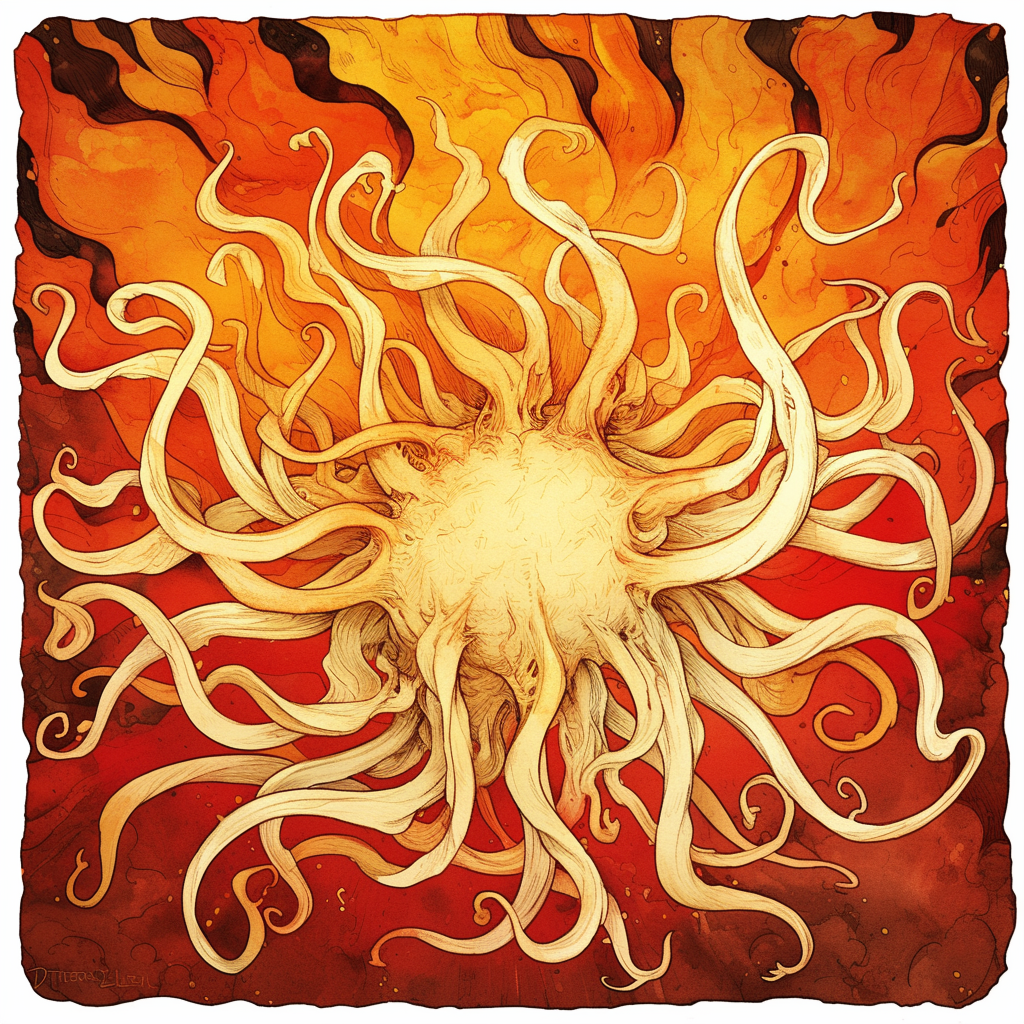
Xac-yel are interesting creatures for sure. They aren’t elementals, but energons. They resemble a cross between a flame spirit and a xag-ya—a ball of white-hot plasma with tentacle-like appendages. Xac-yel are rare and they frighten even fire elementals. See, they embody not basic matter of elemental fire, but thermal energy itself. For them, the freezing wastes of Stygia and the deepest, tungsten-evaporating depths of the Plane of Fire are as different as a zero and a billion to a mathematician—that is, technically very different, but both entirely manageable. Xac-yel are incorporeal and they are always hotter than their surroundings—which means they’re cool on the Plane of Ice, hot on Prime and absolutely scorching on the Plane of Fire. Their touch heats up objects and can damage even fire elementals (they can also project their energy in a ray). Xac-yel are, more than any elemental, the essence of heat itself. Faction scholars from the Guvners to the Sinkers have tried to learn the limits of these mysterious energons, but no berk has managed to even capture one yet. Xac-yel prefer the warmer places, but they like to wander and are attracted to portals they can use to visit interesting planes. While the can appear to be quite sociable, Xac-yel don’t speak and their motives are so far to incomprehensible to mortal minds. They attack xor-yost on sight.
Stats: [ D&D 3e ] Fiend Folio [3e] p119-120

See Also:
Canonical Sources: Start with the excellent Planescape Inner Planes [2e] book. Other references from D&D and Pathfinder lore are mentioned on the relevant entries.
Other Sources: Margarita, Jon Winter-Holt
